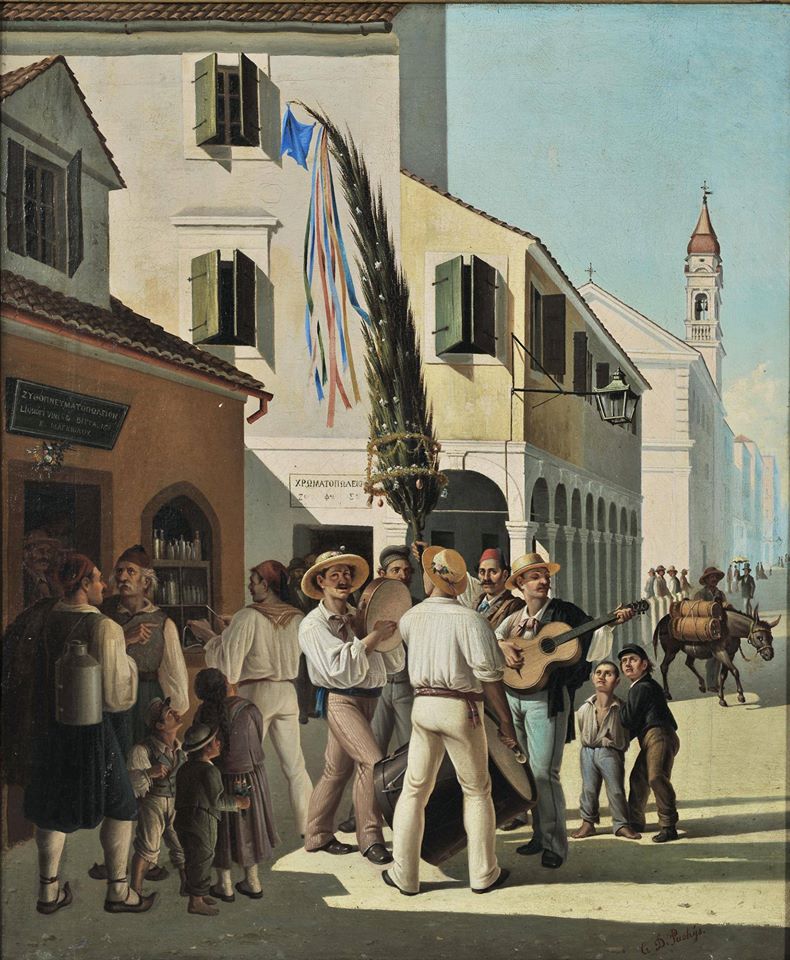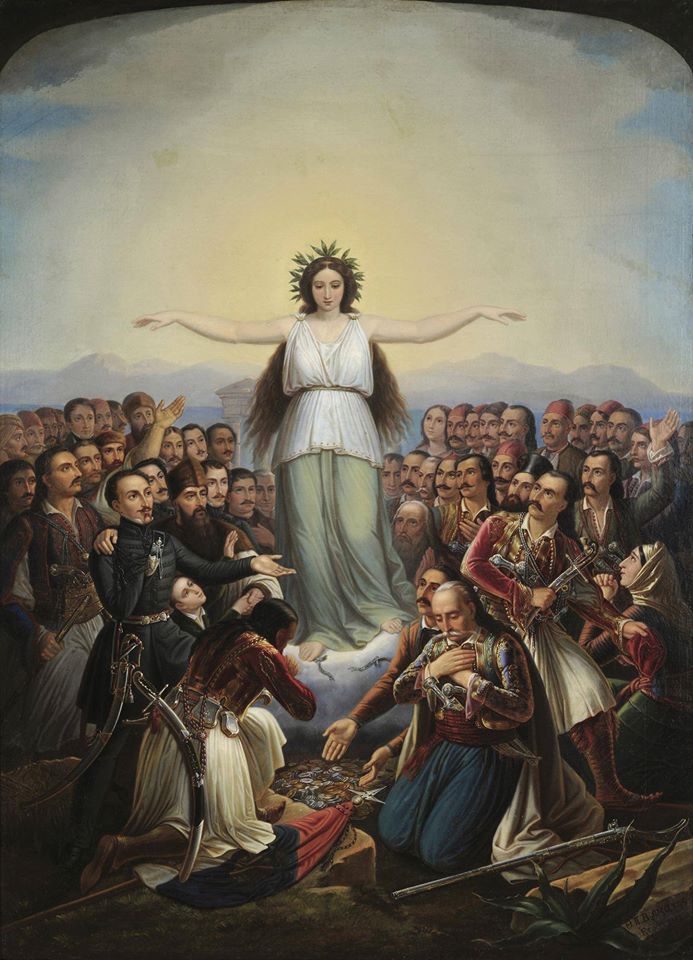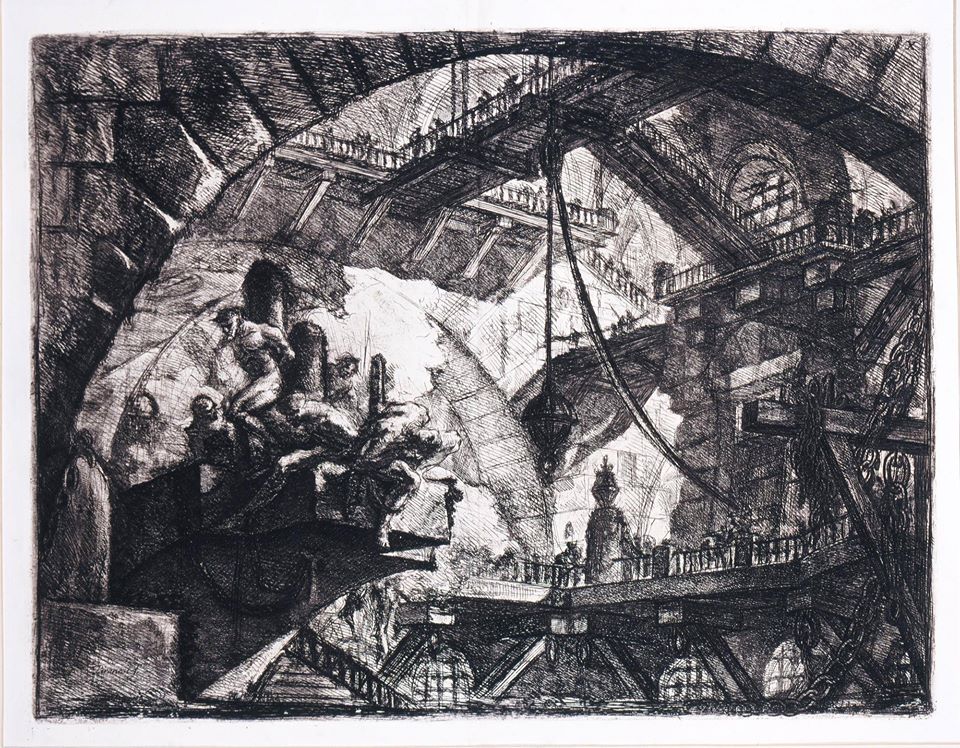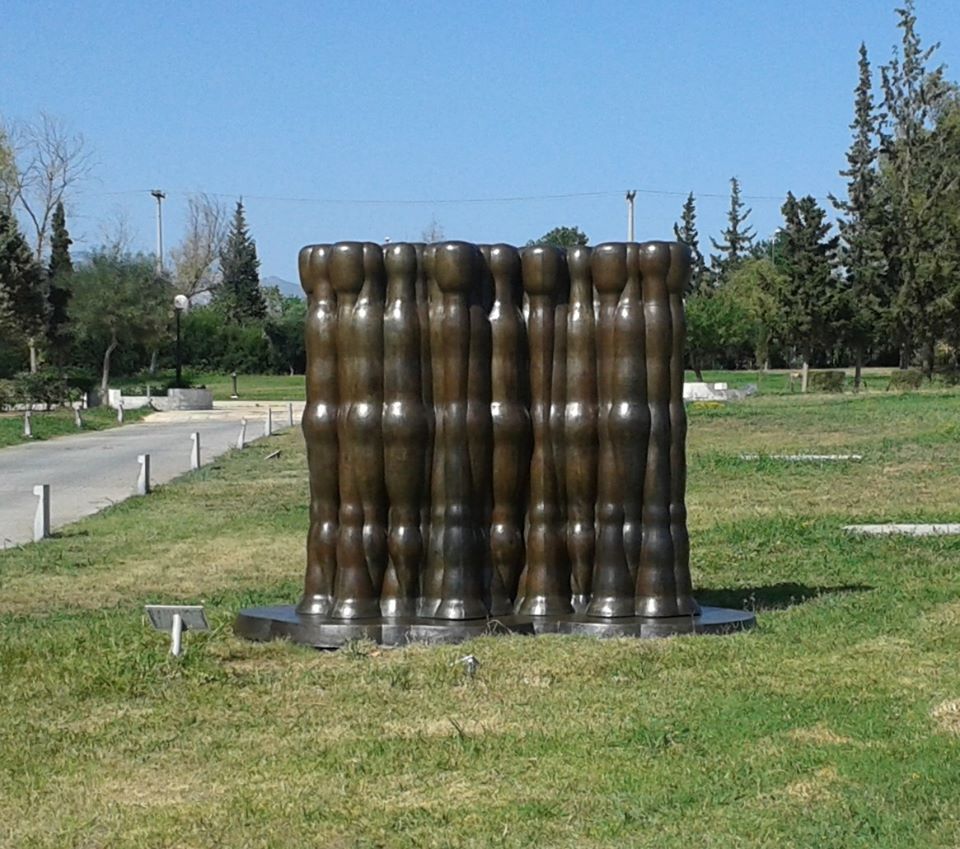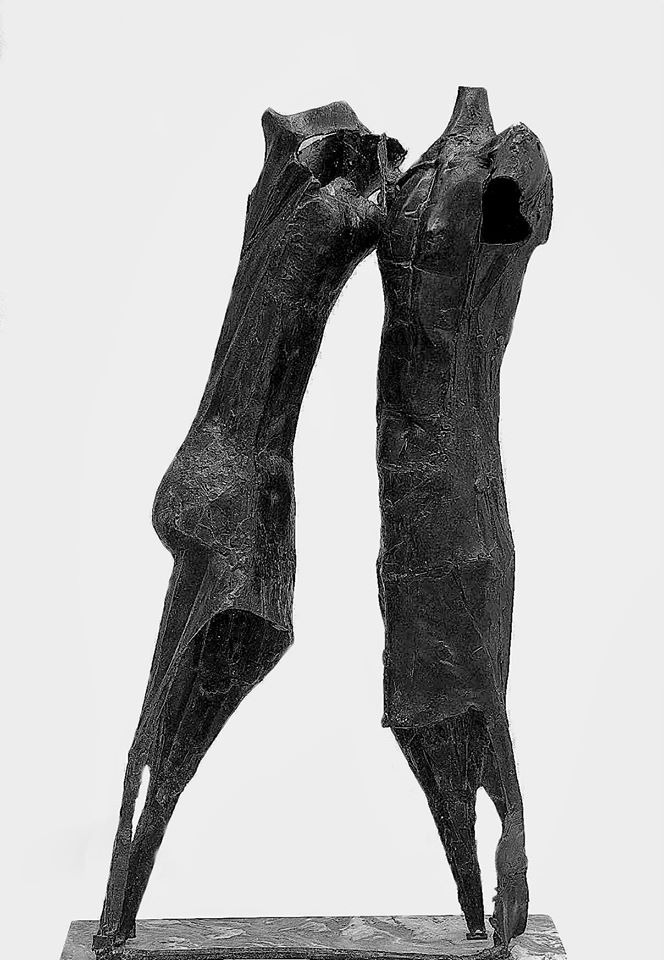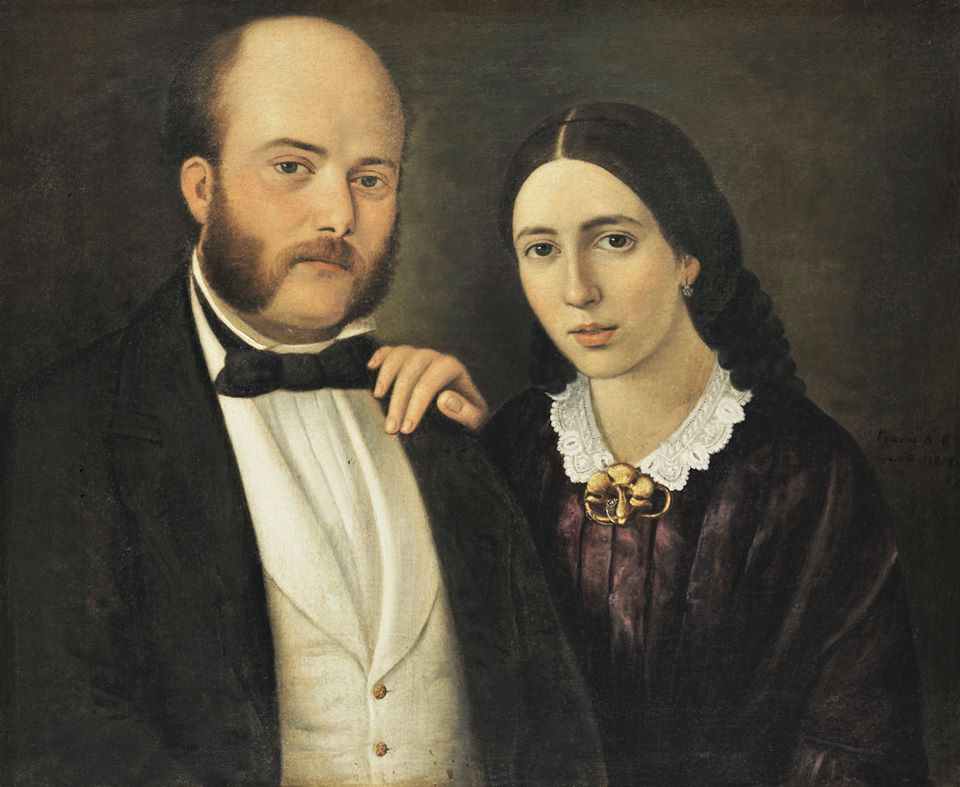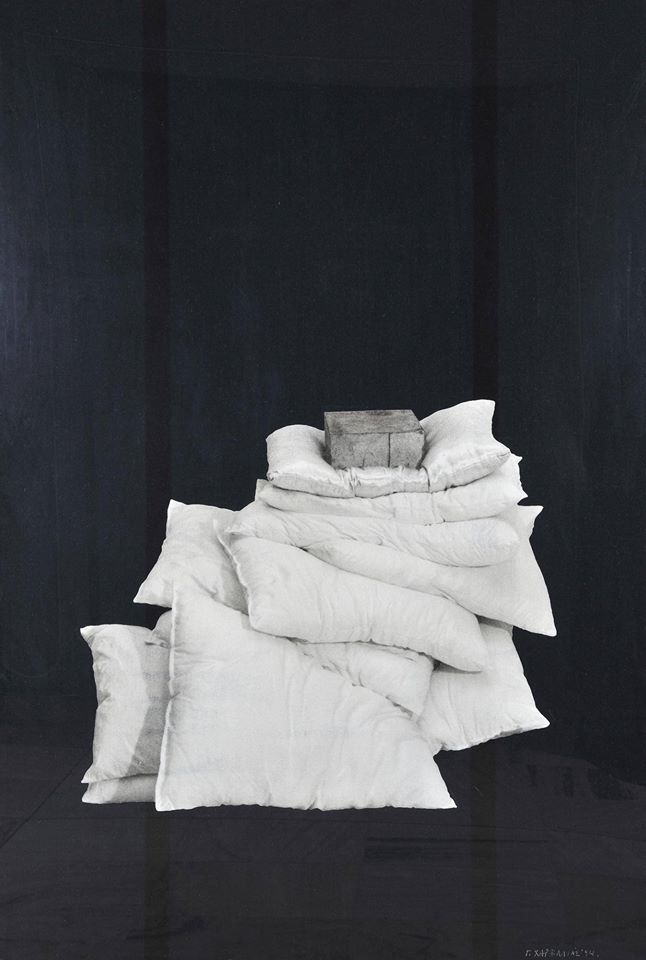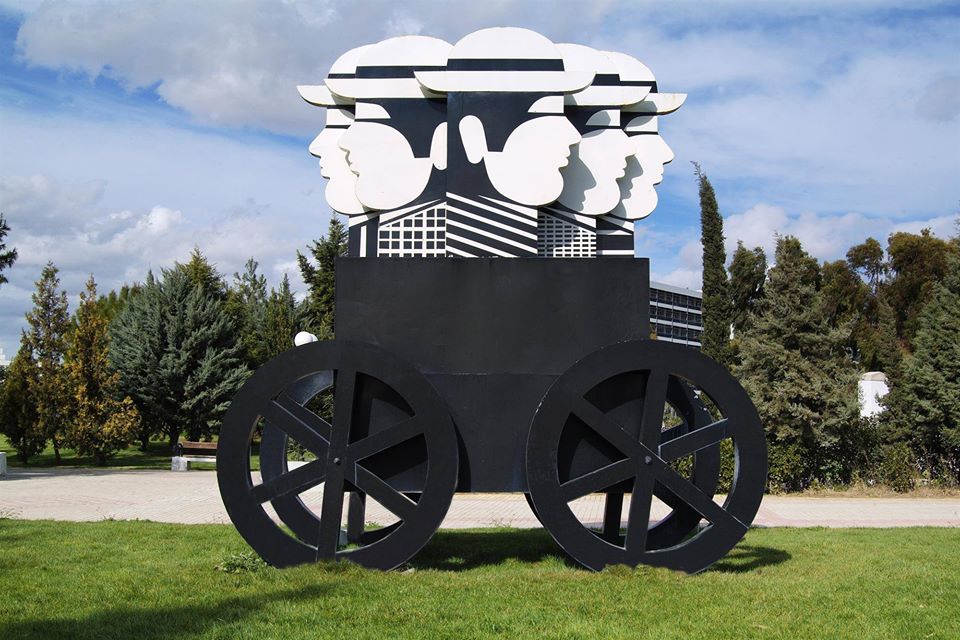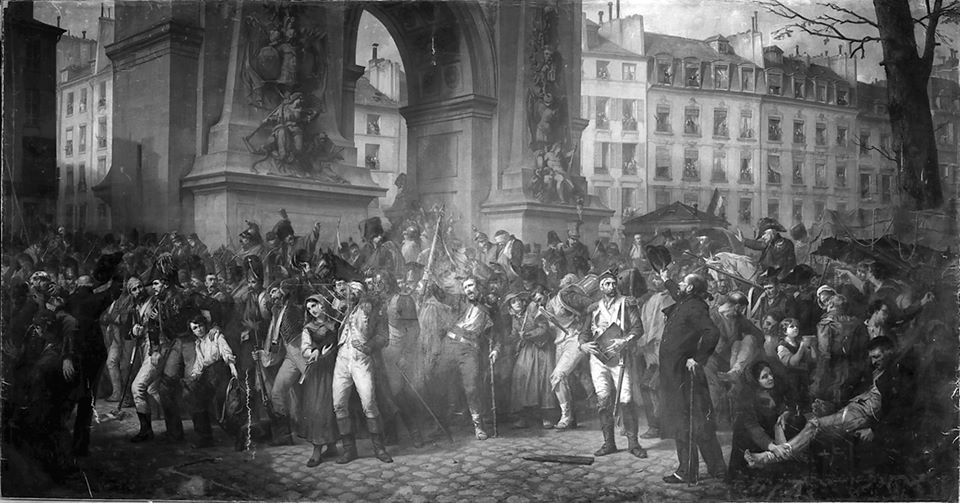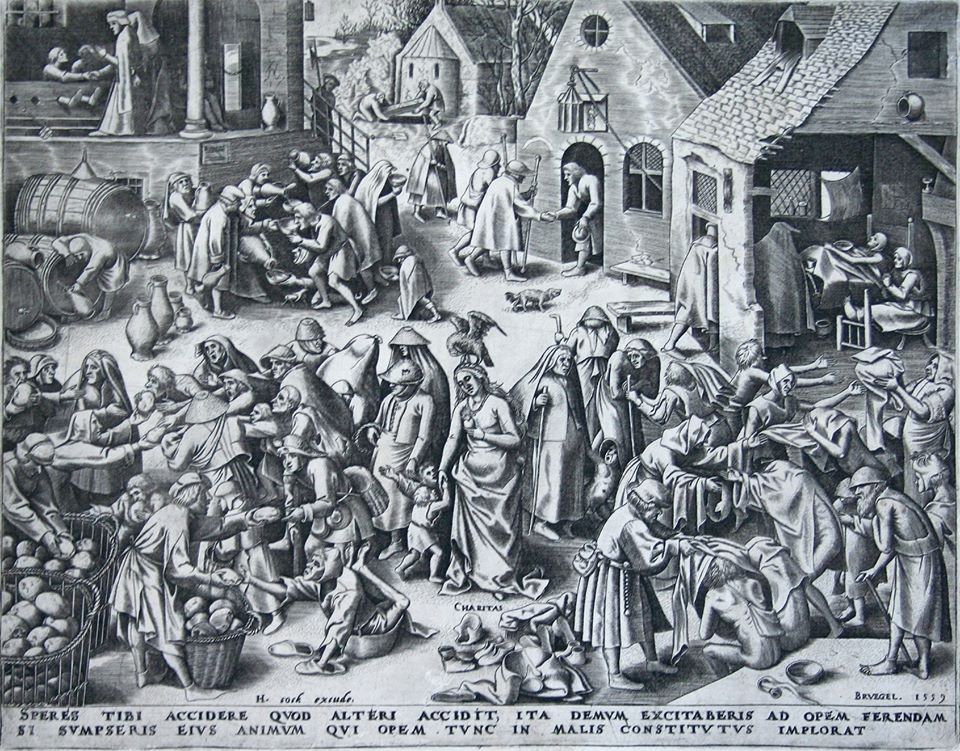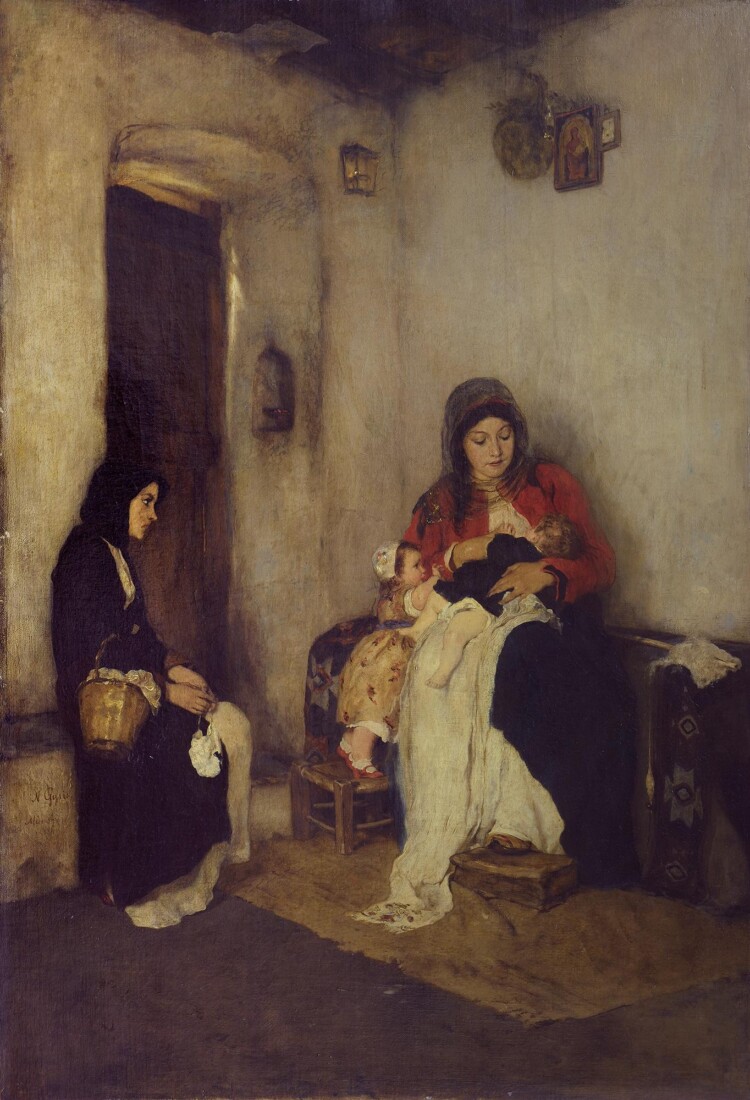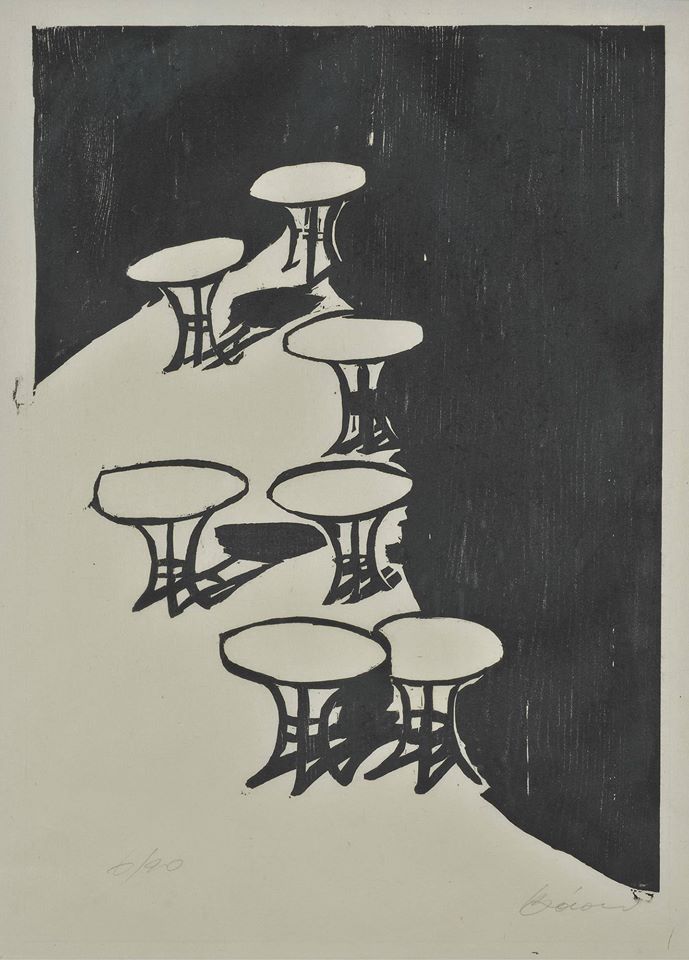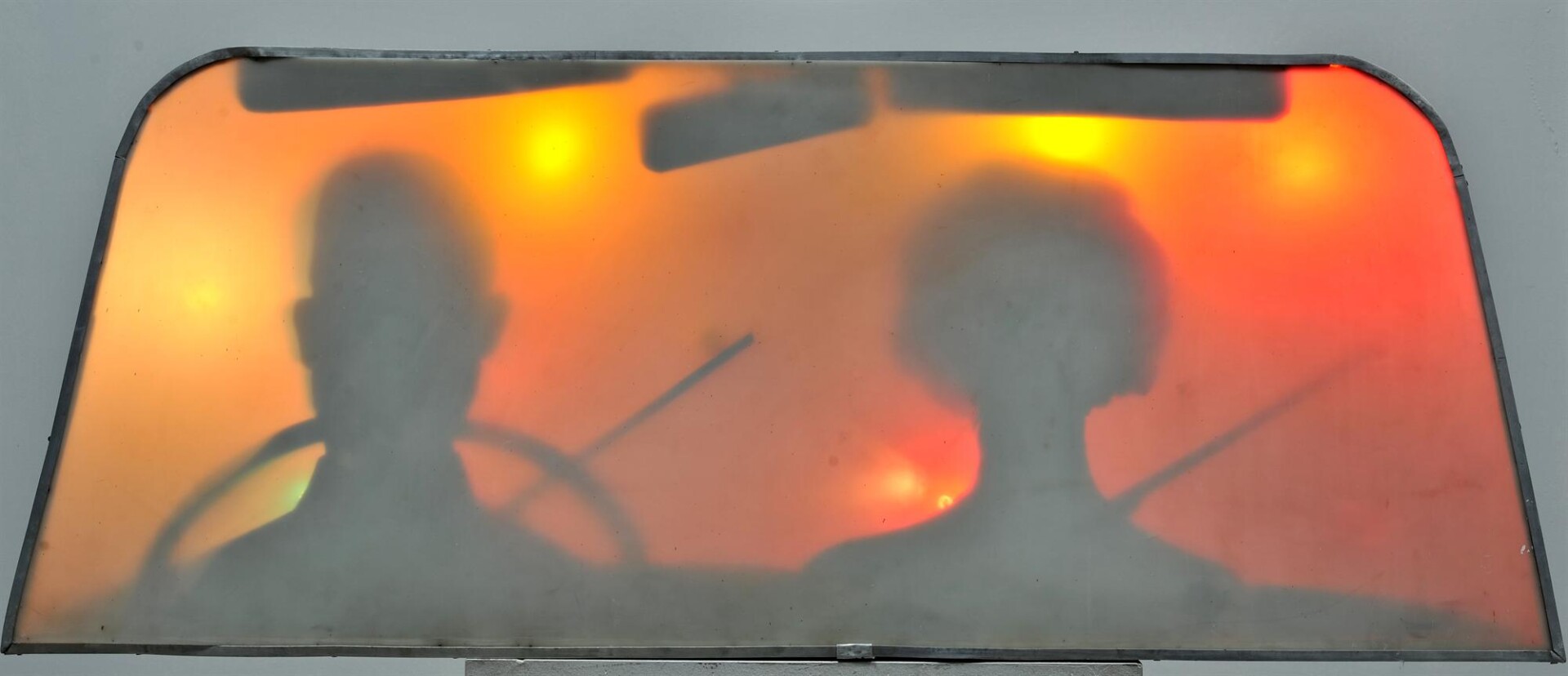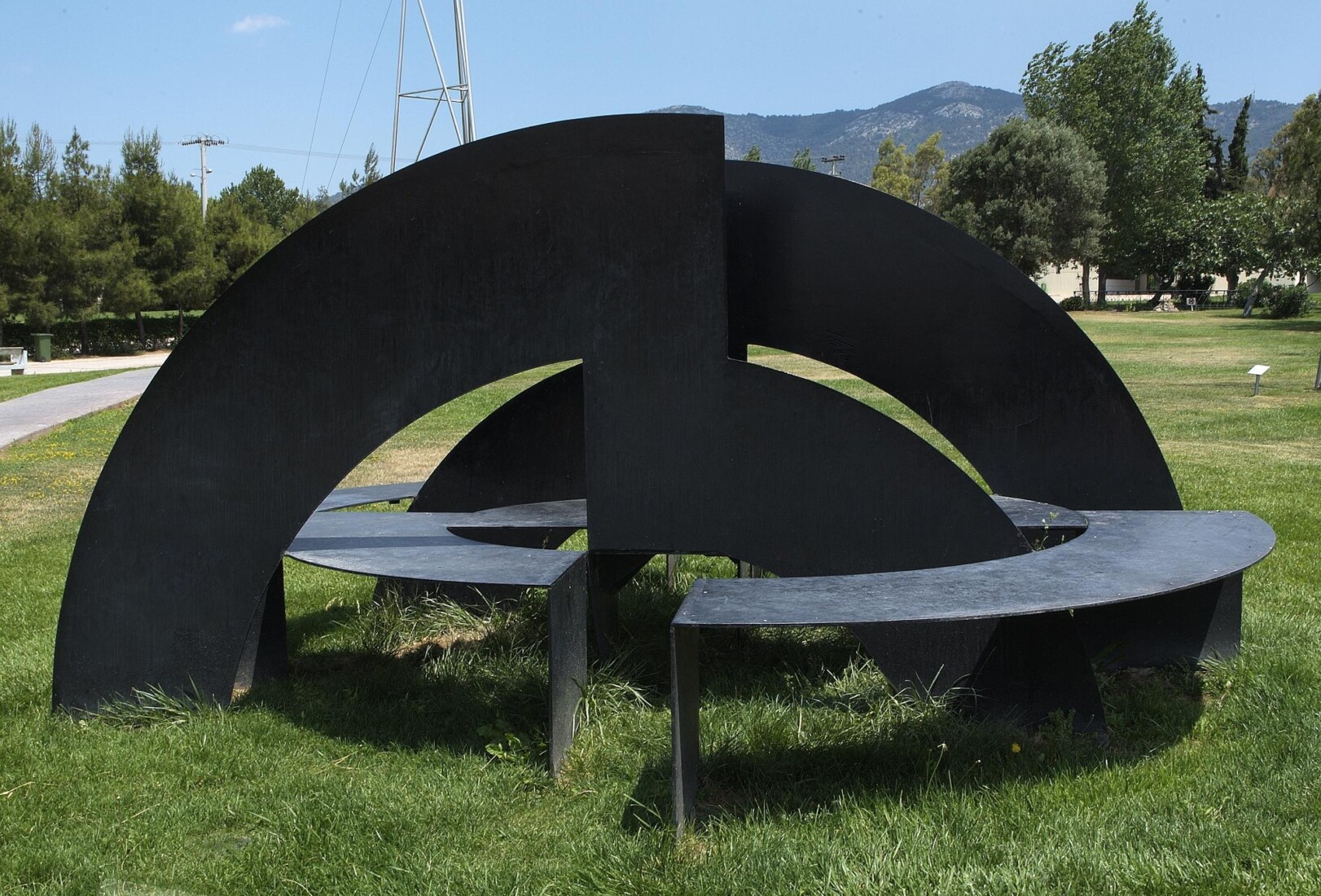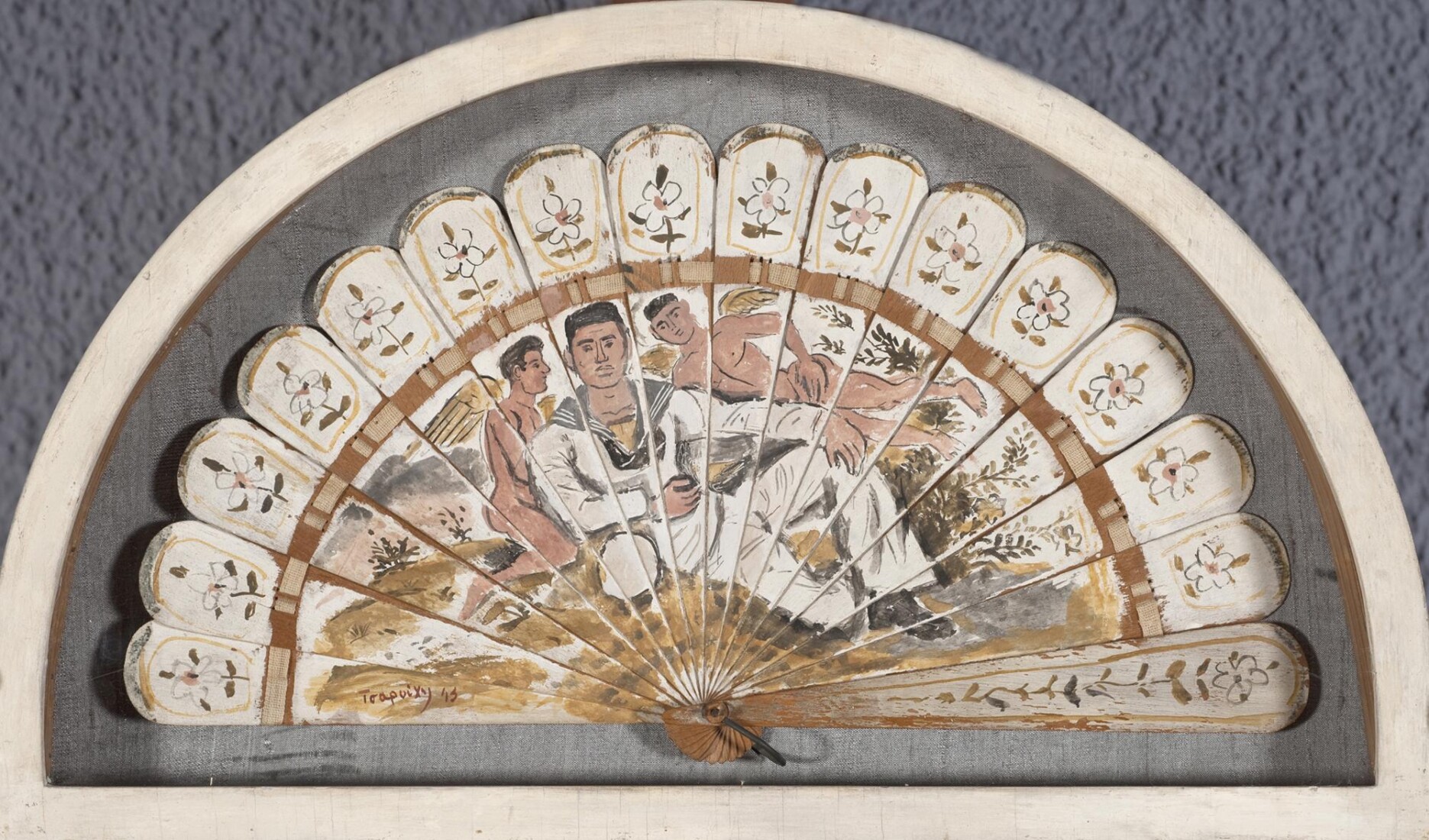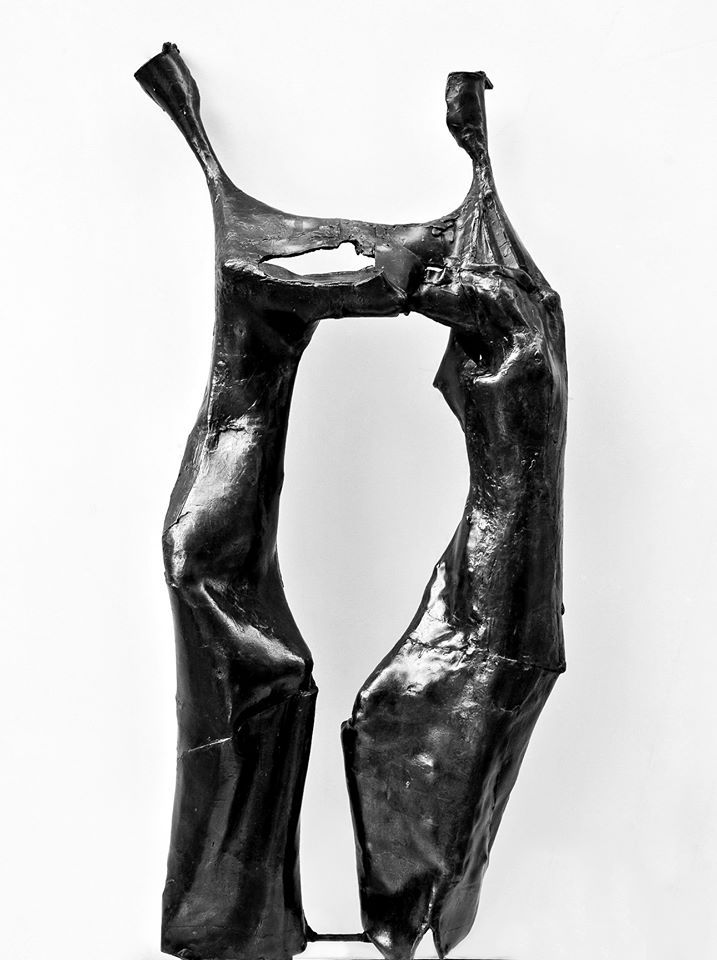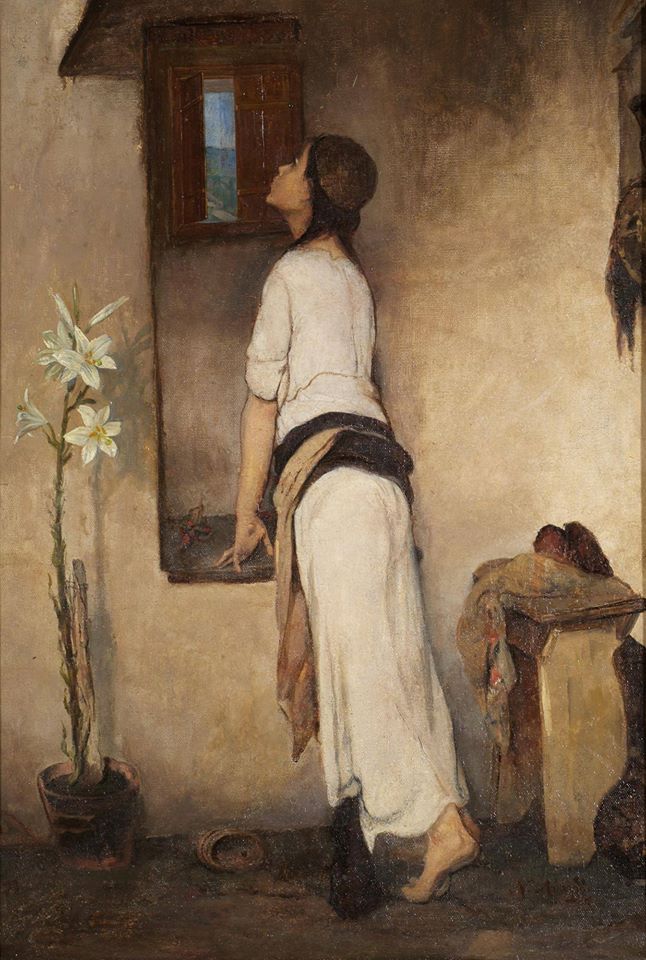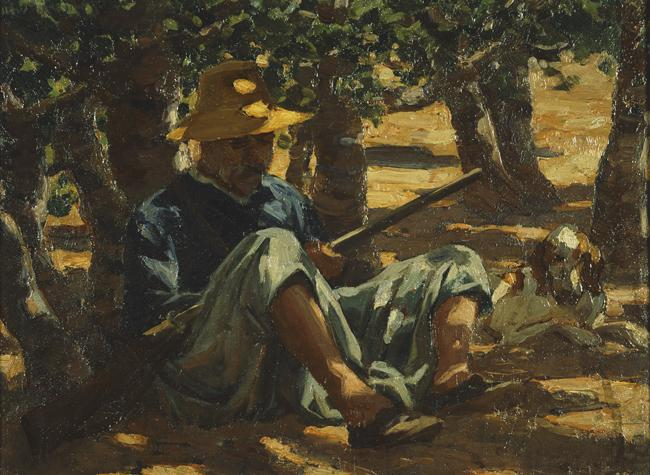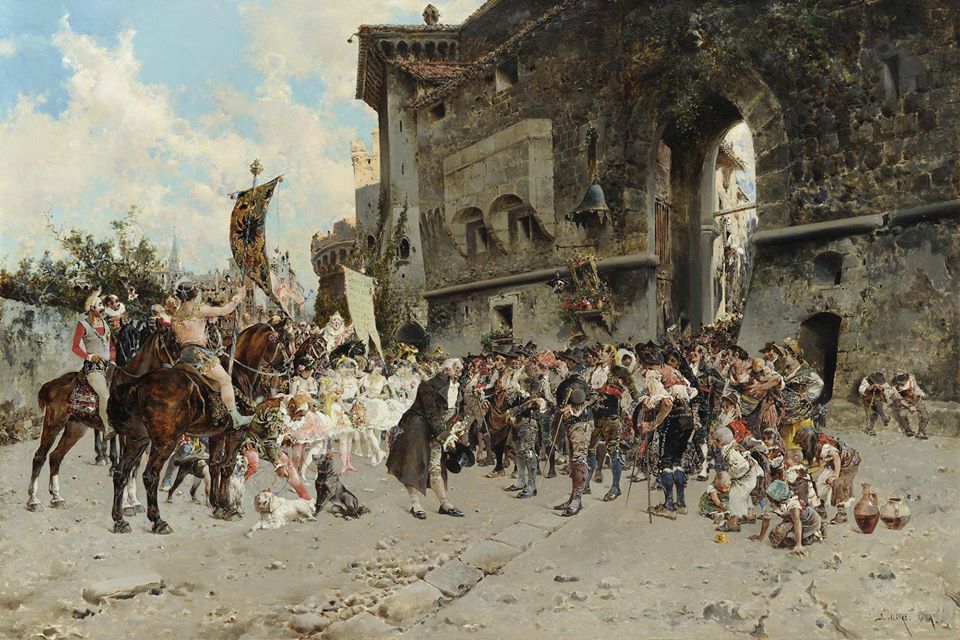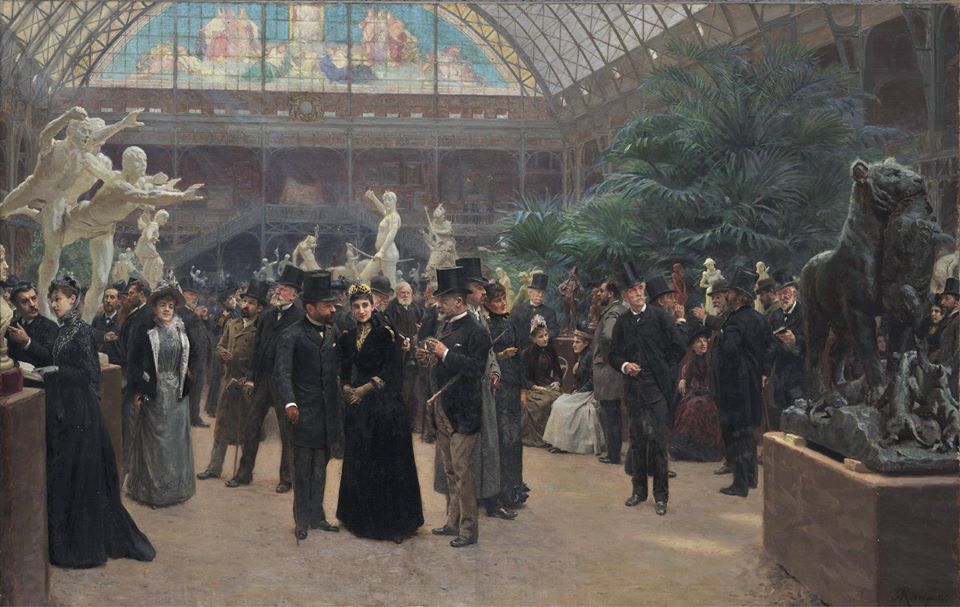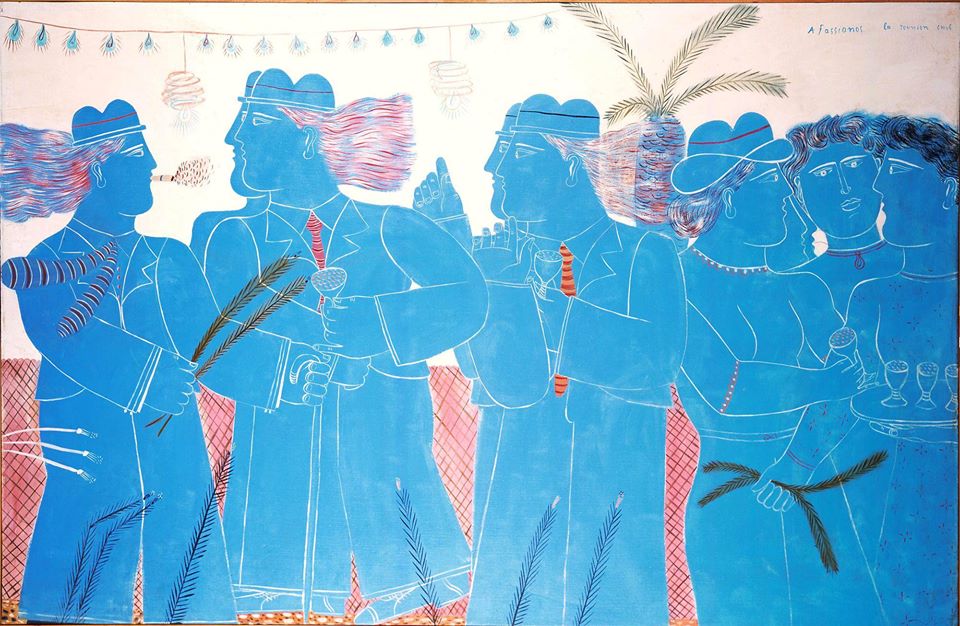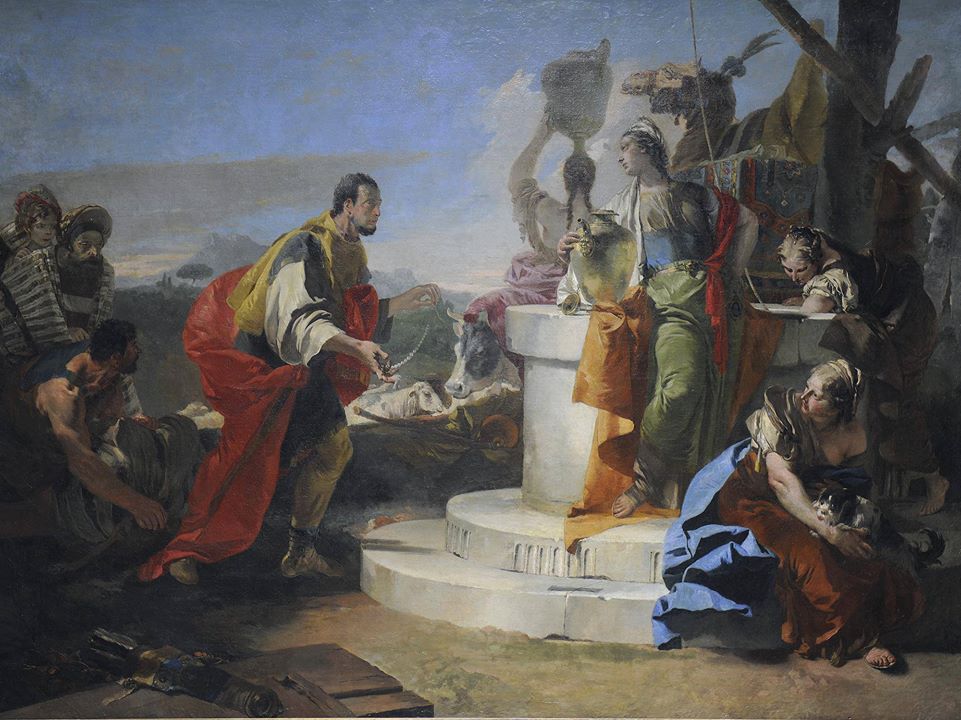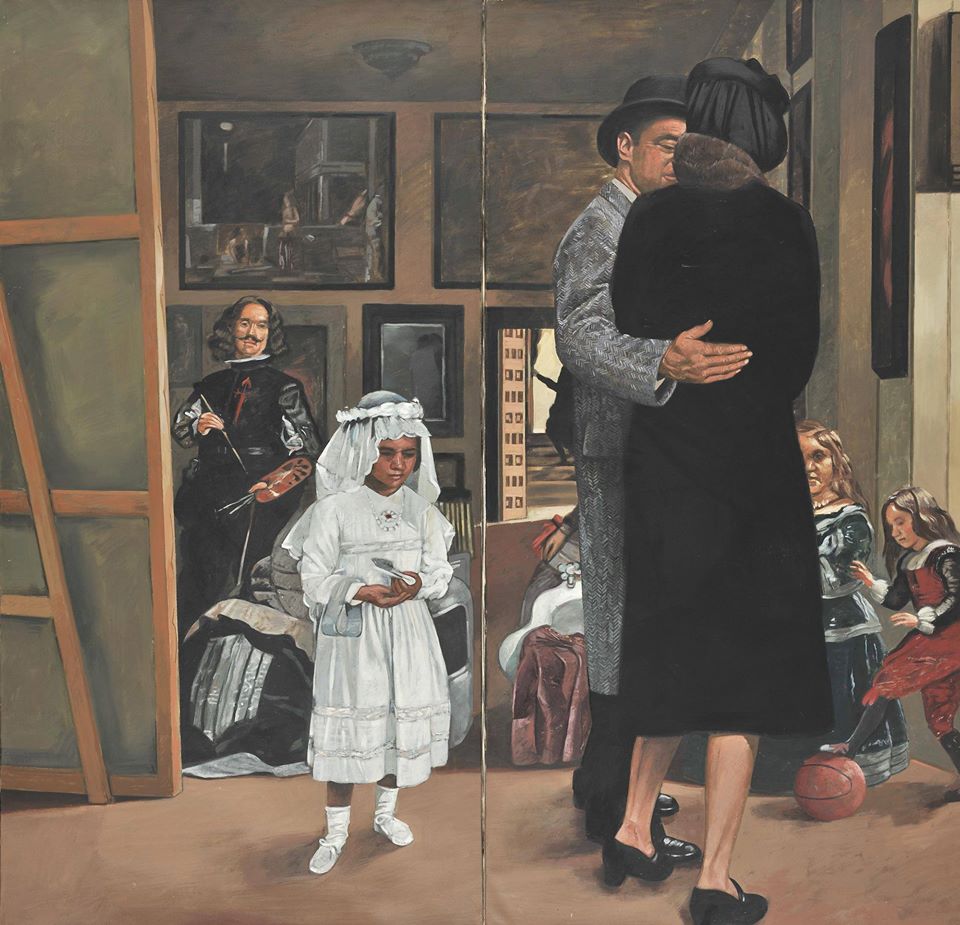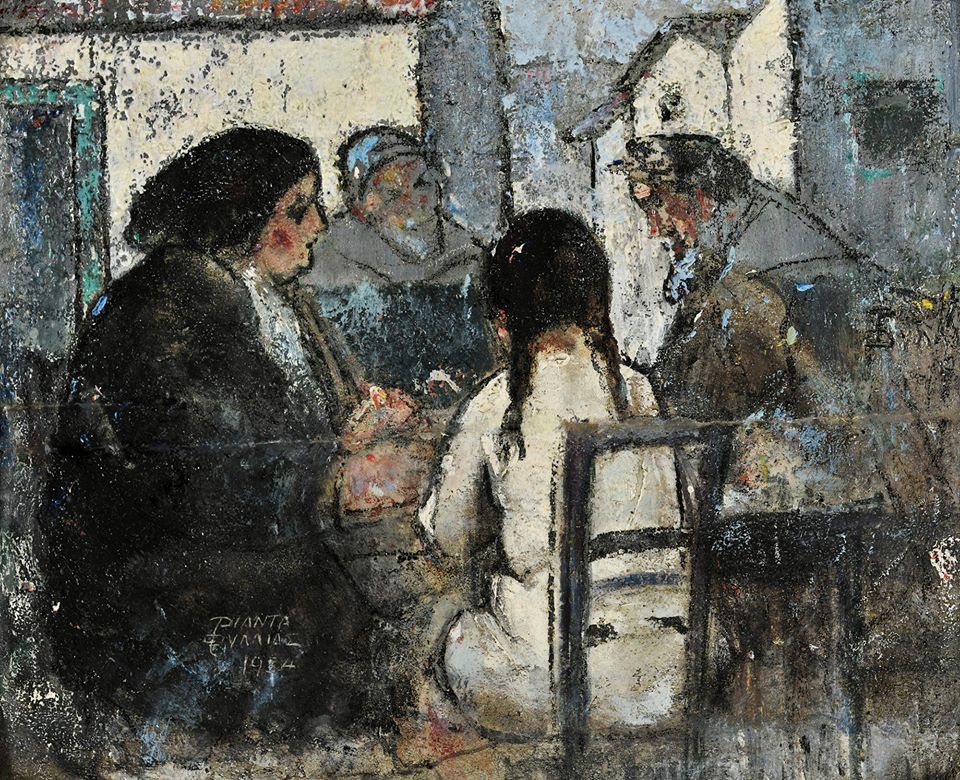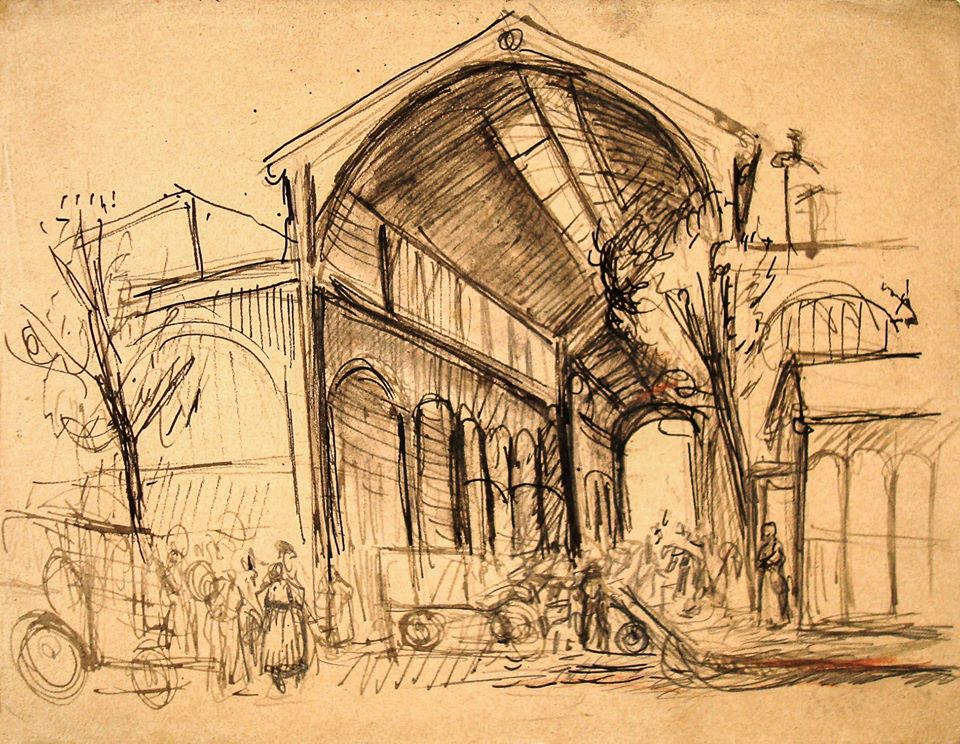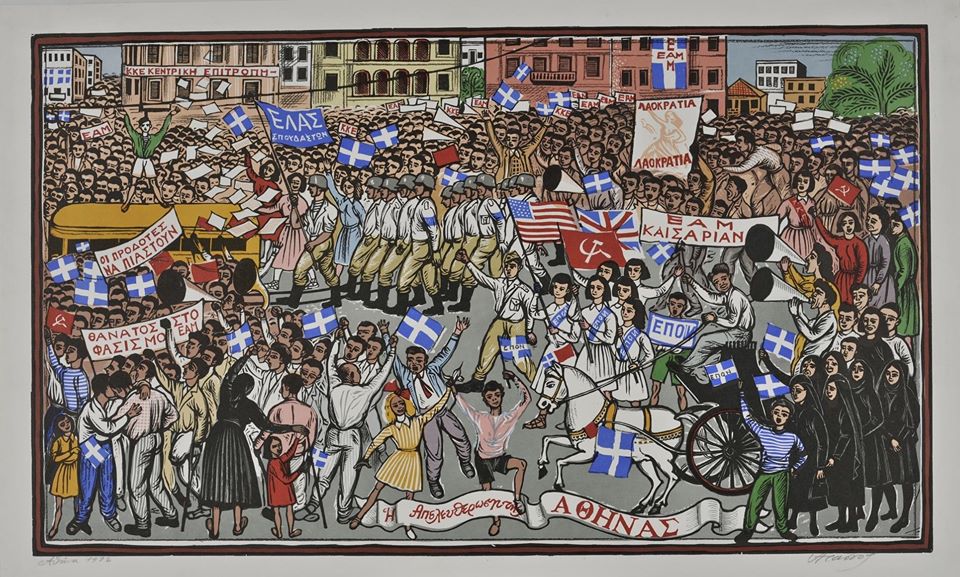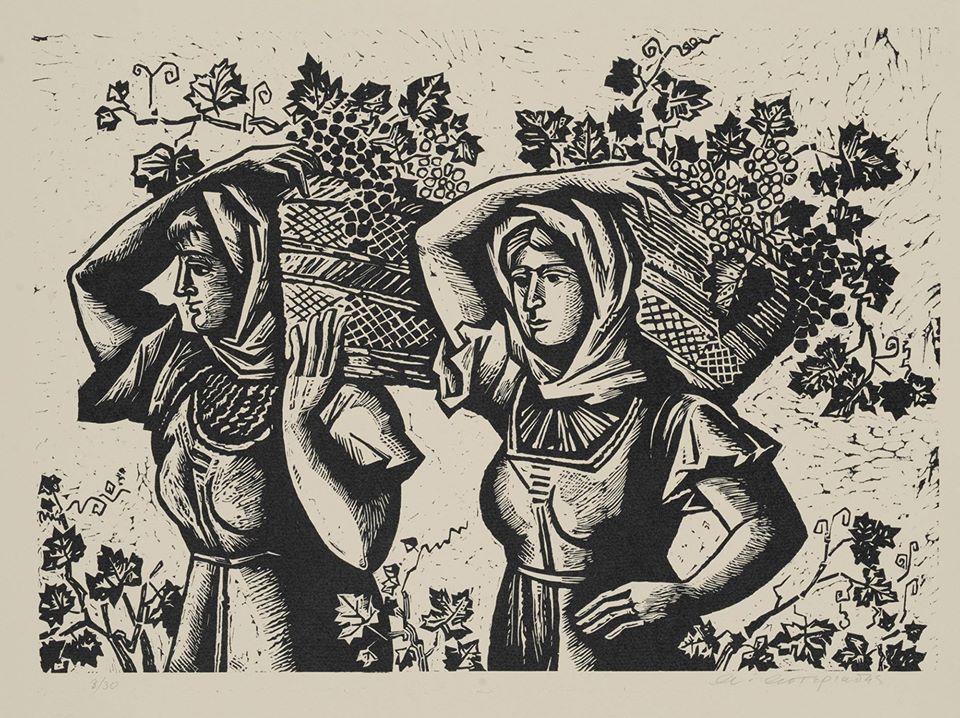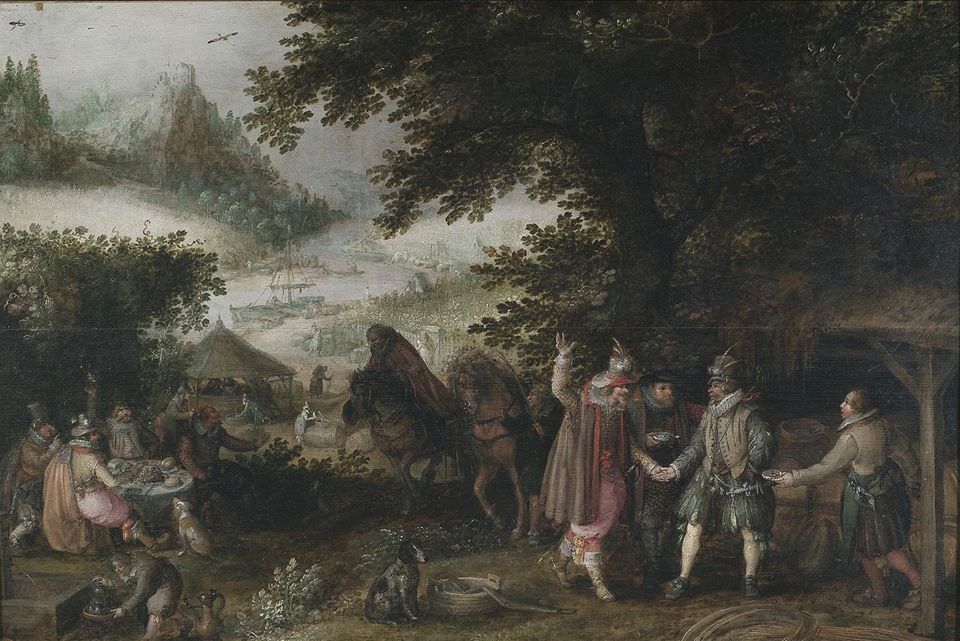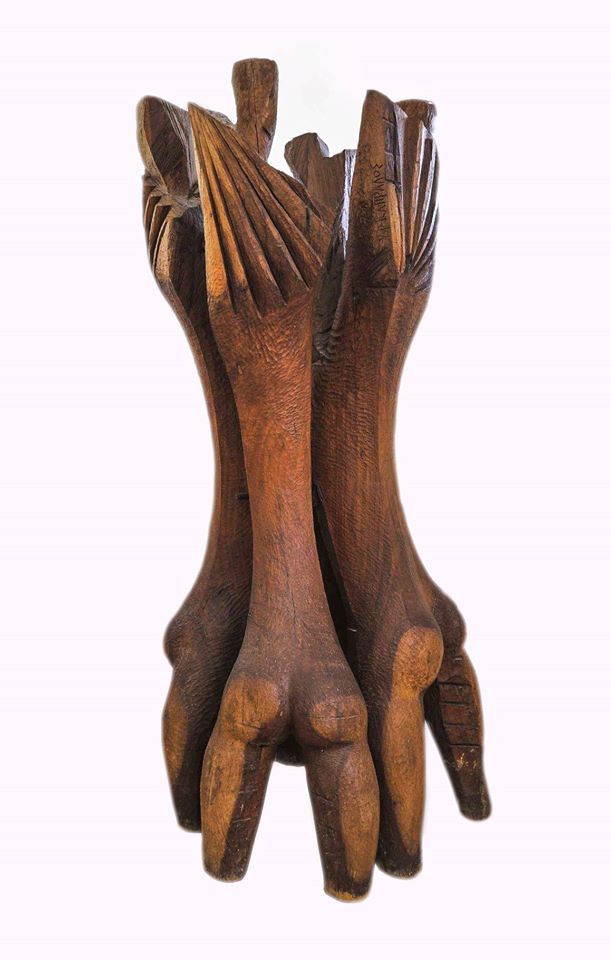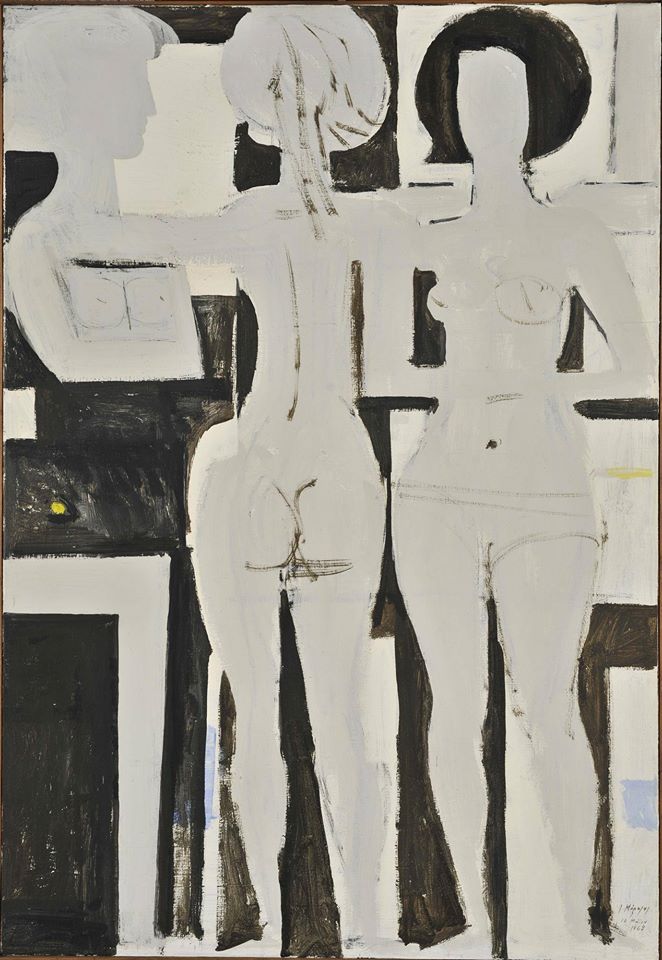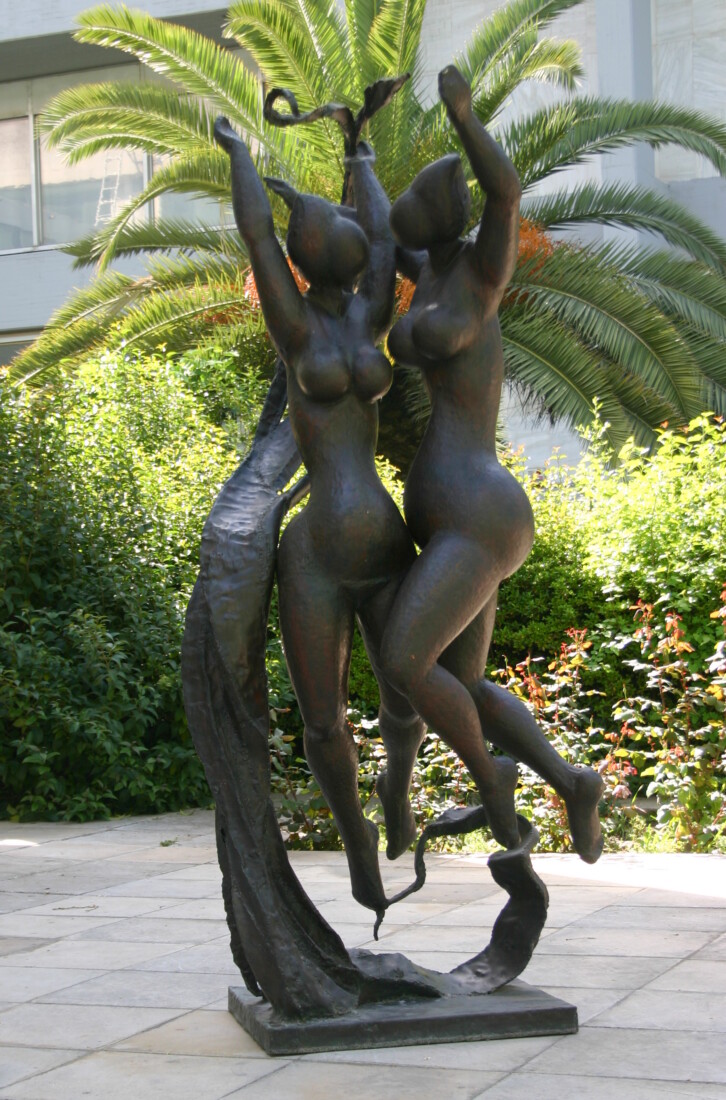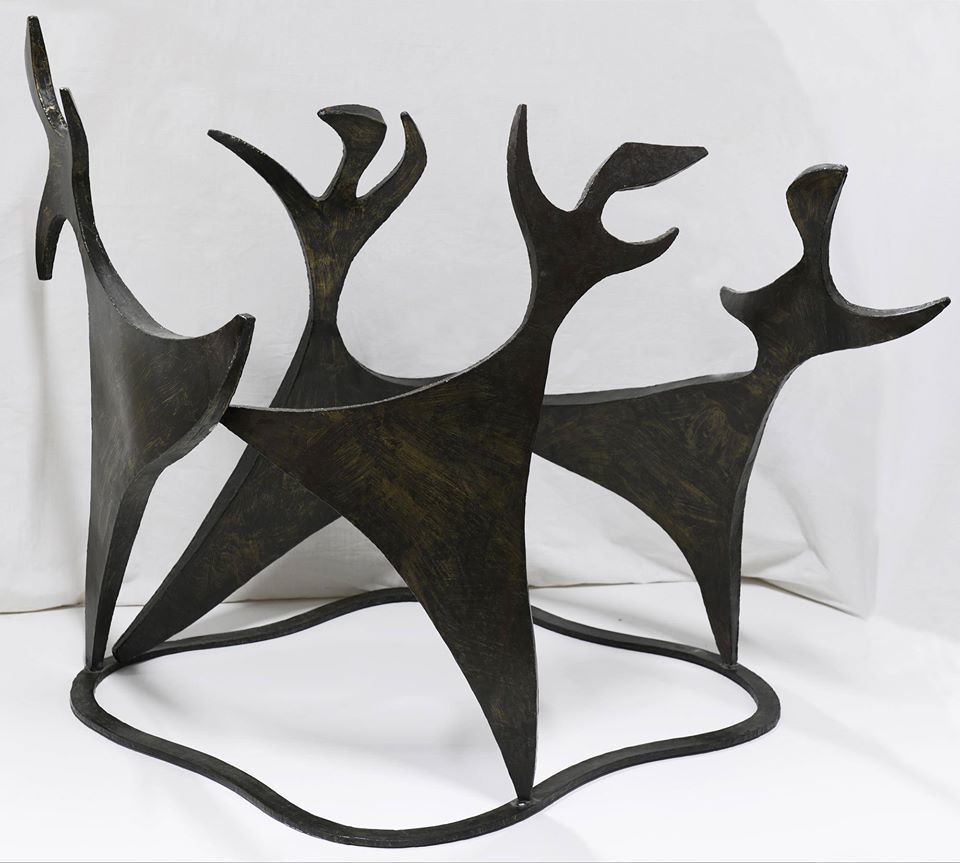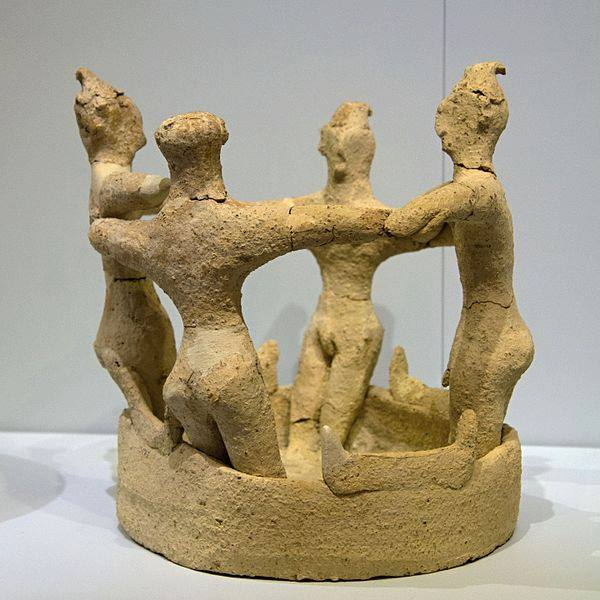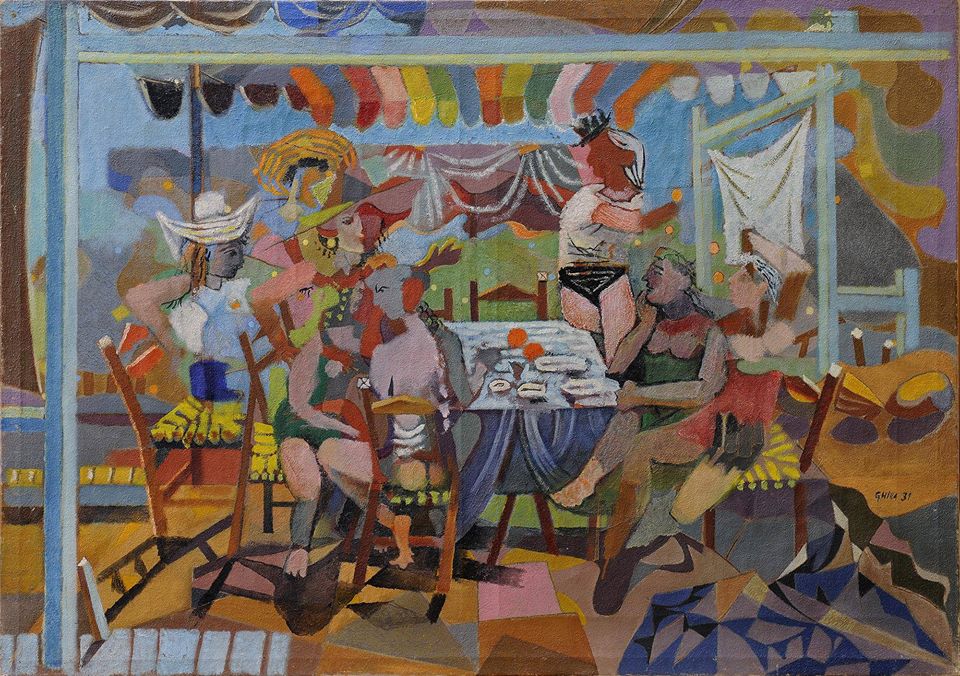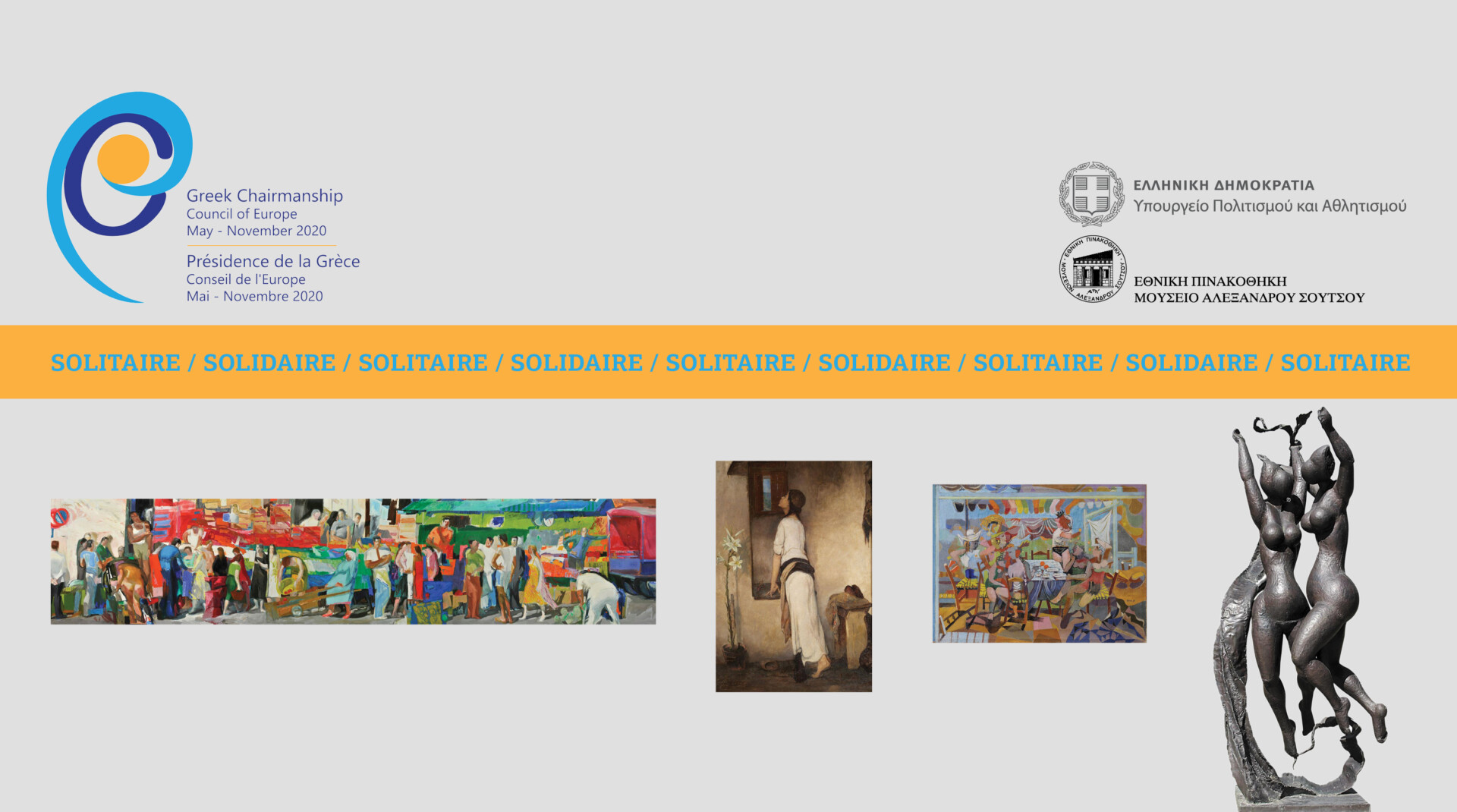
Solitaire / Solidaire, the digital presentation of the National Gallery-Alexandros Soutsos Museum included among the projects of the Network of Contemporary Culture Museums in the context of the Greek Presidency of the Council of Europe (15/5- 18/11/2020), was designed and completed by the curatorial team of the museum during the recent social isolation measures, imposed globally by the unprecedented health crisis.
With the museums closed, away from the artworks and their public, the curators of the National Gallery turned to the museum`s digital record, its photographic and bibliographic databases, but also to their personal research notes and studies, in order to approach the collections from a fresh viewpoint, focused on the timely theme of social cohesion. Coming together with quickness and enthusiasm, they proposed original interpretations of well-known and less-known artworks from all sections of the collections, as a respond to an urgent internal call for participation and contribution, but also to the need to maintain their ties with their work subject and the friends of the museum.
Nearly forty works -the number as a small, symbolic reminder of the quarantine- have been selected and commented on in a condensed, comprehensible way which highlights the importance of collective action, solidarity, mutual obligations and equal rights, not only as means to deal with emergencies, but also asconditionsform achieving universal prosperity.
Solitary, yet solidary, making use of some excellent digital museum applications, the National Gallery via its project Solitaire / Solidaire sends the message that art, as a guardian of great human values, contributes decisively to their protection and cultivation.
SUPERVISION: Marina Lambraki-Plaka. CONCEPT-INTRODUCTORY TEXT: Artemis Zervou. COORDINATION: Efi Agathonikou, Elpiniki Meintani, Artemis Zervou. SELECTIONS-TEXTS (alphabetically): Efi Agathonikou (Western European Painting). Tonia Giannoudaki (Modern Greek Sculpture). Zina Kaloudi (Modern Greek Painting: early 20th cent.-1940). Maria Katsanaki (Modern Greek Painting: 19th cent.). Elpiniki Meintani (Photographic Archive). Katerina Tavantzi (Prints). Lina Tsikouta (Modern Greek Painting: 1945-present). Artemis Zervou (Christos Kapralos Collection). TRANSLATION: Artemis Zervou. PHOTOS-IMAGE PROCESSING: Stavros Psiroukis, Thalia Kymbari.
Charalambos Pachis (1844-1891)
May Day on Corfu, ca 1875-1880
Oil on canvas, 61 x 50 cm
inv. no: 483
Corfiot Charalambos Pachis is one of the artists who introduced genre scenes in the Ionian painting of the second half of the 19th century. On a bright spring day, on a street in the city of Corfu full of shops and houses, workers, shopkeepers, passers-by, Corfiot bourgeois, men from mainland Greece and children stand close and watch a group of young people who play guitars, drums and triangles, singing and celebrating May. In the middle of the musicians` circle, a man in a red fez, looking directly at us, is holding up the May Day tree, adorned with flowers, fruits, wreaths, colorful ribbons and a blue scarf on top. The tender green tree trunk carried around by the youth, according to the Corfiot custom, is the cheerful and flourishing symbol of the eternal rebirth of nature and, consequently, of the victory of life, which fills the hearts with joy and becomes the occasion of a broad celebration.
Maria Katsanaki
Theodoros Vryzakis (1814-1878)
The Defense of Homeland Above All Else, 1858
Oil on canvas, 183 x 132 cm
Donated by the University, inv. no: 643
The painting depicts an imaginary assembly of all those who prepared and served the Greek Revolution, joining the common ultimate cause – from Rigas, Korais and the Ypsilantis Brothers to Bouboulina, Miaoulis, Papaflessas, Karaiskakis, Kapodistrias and Byron. With their desire for freedom and independence now fulfilled, and the nation state already a reality, they come together under the arms of Greece, embodied by a female figure with ancient Greek references. Vryzakis, the most prominent Greek painter of historical subjects, delivers a unique allegorical depiction of Greece, who, freed from her shackles, laurel-crowned, serene and solemn, tilts her head, extends her arms and pays grateful tribute to her natural and spiritual children.
Maria Katsanaki
Giambattista Piranesi (1720-1778)
Prisoners on a Projecting Platform, from the series Prisons of the Imagination (Carceri d` Invenzione), Χ 1761
Etching, 53,5 x 74 cm
inv. no: 2510
A stressful atmosphere of confinement, with a multilevel spatial layout reflecting the complexity of human psyche, and an intensely dramatized chiaroscuro symbolizing, for contemporary man, rekindled inner fears associated with deep existential needs for security, abundance, free creative expression, and a joyful communion with fellow human beings -values theoretically non-negotiable, though constantly proving so fragile. On the other hand, the strange presence of figures-observers who, albeit imprisoned, do not fight. Distancing due to fear, doubt, hesitation? In the foreground, a stone arch, as a semantic reference to a psychologically “ring-pass-not”, delimits this introversion through the paradoxical form of an opening, which can lead either to another, even more secluded, space or to an expanded horizon of deliverance –all depending on humans’ will. Prisons that are mainly existential, imaginary shackles we are called to shake off, both individually and collectively, by reflecting how close to spiritual and emotional freedom the struggle of the figures on the left platform can take place.
Katerina Tavantzi
Joannis Avramidis (1922-2016)
Polis, 1965-68
Bronze, 203 x 270 x 135 cm
Donated by the artist, inv. no: 6413
Joannis Avramidis reminds us we are all equal. By repeating nine times the full-length, vertical, stylized figure so characteristic of his work, he creates a compact group, comprised of figures sharing the same size and common characteristics, in order to materialize the idea of a community, where all citizens are equal.
Tonia Giannoudaki
Christos Kapralos (1909-1993)
Mother and Daughter II, 1963
Bronze, 147 x 77 x 38 cm.
Former Christos and Souli Kapralos Foundation, inv. no: 11756.
In this version of the sculptor’s favourite Mother and Daughter subject, Kapralos
explores the sculptural dynamics of a pair of standing figures and, with a slight deviation of the viewer’s left vertical axis, he places the two convergent female bodies in a weak-strong interrelated position. Both adults, without any special identity traits, they compose an interesting enigma: who is the mother and who is the daughter? Which one is supporting, and which one is being supported? Do they, ultimately, exchange roles, depending on the episodes of life?
Artemis Zervou
Dionysios Kallivokas (1806-1877)
Portrait of Man and Wife, 1858
Oil on canvas, 48 x 58 cm.
Ε. Koutlidis Foundation Collection, inv. no: K.769
The naturalness with which the portraits by Zakynthian Dionysios Kallivokas depict members of the Ionian society, distinguishes them from the austere portraiture of the first half of the 19th century, where sitters appear quite inaccessible. The couple of this painting belongs to the bourgeoisie. The kindness of their faces harmonizes with the subtlety of the painting technique. The spouses’ calm pose betrays a relationship of intimacy and trust: the physical closeness and contact, the slight turn of one body towards the other and the convergence of their heads create a closed form, which reflects their unbreakable companionship. He looks gentle; she is emanating an air of sweetness, that permeates her gaze, the touch of her hand, and her imperceptibly open lips. They both radiate confidence and faith: they look at life and experience its every aspect together, as one.
Maria Katsanaki
Giorgos Charvalias (1956)
Compression Type, 1994
Print on army navy blanket, 207 x 142 x 3 cm
Donated by the artist inv. no: 11809
The work features a thin black navy blanket with an imprint of a stack of white pillows compressed by a box. Using new media within a conceptual framework which upgrades the trivial and the everyday object to an artwork level, yet without dismissing its political dimension, Charvalias engages with many European and American avant-garde movements of the 20th century, while proposing new forms. In terms of our thematic project, pillows here are symbolically transformed into human figures, implying physical intercourse. According to the artist, the pillow is an anthropometric object, and therefore, a measure of human body. The work, thus, becomes a metaphor of various aspects of the world’s current condition: a constant compression of people in their daily lives, as in the subway; stress due to the economic crisis; recent pressure caused by the isolation measures and the prohibitions, imposed due to the coronavirus pandemic. Successfully symbolic, the work lets us acknowledge a reference between the pillows-objects and human compression.
Lina Tsikouta
Yannis Gaitis (1923-1984)
Mass transportation or General Transports, 1984
Iron and paint, 550 x 460 x 200 cm
inv. no: 7082
Motionless, firm and expressionless, deprived of any individual characteristic, the small man of Yannis Gaitis became the protagonist of his compositions, a means to express his critical and ironic view against the massification and alienation of urban residents. “Mass transportation” or “General Transports”, with the various associations it evokes, reminds us of our life’s previous condition and gives us reason to wonder whether we will return to the same or a different, less impersonal, everyday life.
Tonia Giannoudaki
Charles Louis Müller (1815-1892)
30 mars 1814, 1855
Oil on canvas, 445 x 845 cm
Donated by Alexander Kitroeff, inv. no: 161
March 30, 1814. Prussian, Austrian and Russian troops have reached the outskirts of Paris, yet Napoleon, despite his repeated defeats, continued to send victorious messages to the French capital. Even on March 28, the “Journal de L’ Empire” reported the victories of the French troops at Chaumont. Thus, when the allies arrived outside Paris, the French, surprised and shocked by the events, ran to defend their city. The painting depicts a strange mix of people -wounded, elderly, children, women, war prisoners, ordinary citizens etc.- gathered at the Porte-Saint-Denis, a landmark of the French capital, in a desperate and hopeless attempt to defend their city. The next day, March 31, allied forces entered Paris. As in The Exodus from Missolonghi (1853), a nearly same-date work by Theodoros Vryzakis, Muller’s painting praises the collective fight to death of ordinary people in defense of their Freedom.
The restoration and presentation of this enormous work at the Permanent Exhibition of the new National Gallery of Athens, is an exciting challenge accepted by the staff of the museum.
Efi Agathonikou
Pieter Brueghel the Elder (1525-1569)
Charity, from the series The Seven Theological Virtues, 1559
copper engraving, 25,5 x 3,7 cm
inv. no: P.3504
A 16th century village square, transformed from a predominantly public place of commercial activities into a stage for the seven manifestations of the Christian virtue of Charity, organized around her central allegorical figure. Symbols of Divine and Human Love, the burning heart Charity presses on her chest, the pelican sitting on her head, ready to peck at its own body to feed its young with its own blood, and the two children Charity holds by the hand. Through the realistic depiction of acts of solidarity towards the destitute people of that era (feeding the hungry, giving water to the thirsty, visiting prisoners, burying the dead, offering shelter to travelers, consoling the sick, clothing the naked), an effortless association emerges with our own world today, where the need to support our neighbor is greatly increasing under the conditions of a global crisis, which expands with remarkable aggressiveness as part of the mass urbanization of our times. And the physical body, through the extended giving hand, becomes a semantic sign of the inner human substance, where an ontological encounter occurs with the essential, existential part of the Other, in such a way that every personal offer of our heart opens it up for a unifying embrace with the collective Whole in which every single one of us acts as a cell.
Katerina Tavantzi
Maria Chroussachi (1899-1972)
The British Red Cross in the Greek countryside after the World War II, 1945-1946.
Photographs F_XR_ALB_14
From winter 1945 to spring 1946, in the context of Great Britain`s assistance provided for the postwar reconstruction of Greece, the British Red Cross offered its services by touring areas of the Greek countryside that had been isolated, due to war-torn transport infrastructure, and suffered from malaria, scabies, anemia, vitamin deficiency etc.
Maria Chroussachi, a volunteer nurse at the Hellenic Red Cross herself, joined one of the units of the British Red Cross and recorded its activities, regarding mainly the medical examination and preventive vaccination of children. The photographs depicting volunteers taking care of children are achievements of historical documentation, artistic composition and compassionate empathy.
Chroussachi portrays her subjects with respect and discreet emotional involvement, and manages not to slip into a forced emotion – otherwise easily attainable by her subject matter itself and the children’s destitute appearance- by creating images-mediators of humane values: dignity, solidarity, social cohesion and hope for the future. The joyful shots of the unit members off duty, depicted either with each other or intermingling with the locals, illustrate concepts such as harmonious coexistence, thankfulness, personal gratification stemming from community involvement, and social interaction.
These photographs, as a whole, constitute a unique historical and humanistic record, which summarizes the dreams and expectations of postwar Greece, by recording and honoring the healing process and reconstructing experience of a society, as a collective effort and adventure.
Elpiniki Meintani
Image captions:
1, 2, 3. Maria Chroussachi (1899-1972), Taking care of children, St. George village – Tymfristos, Winter 1945, F_XR_ALB_14_204, 205, 214
4. Maria Chroussachi (1899-1972), Clothing distribution to children, Fthiotida, 1945, F_XR_ALB_14_122
5. Maria Chroussachi (1899-1972), Unit departure, Stylida, 1945, F_XR_ALB_14_136
6. Maria Chroussachi (1899-1972), Members of the unit, Florina, c.1945-1946, F_XR_ALB_14_388
7. Maria Chroussachi (1899-1972), Farewell photo, Florina, c. 1945-1946, F_XR_ALB_14_393
8. Maria Chroussachi (1899-1972), Village children saying goodbye to the unit by singing, Florina, c.1945-1946, F_XR_ALB_14_397
9. Maria Chroussachi (1899-1972), A Scottish from the unit playing bagpipes to villagers, Fthiotida, 1945, F_XR_ALB_14_172
10. Maria Chroussachi (1899-1972), Members of the unit with a family from the village, Chalkidiki, c.1945-1946, F_XR_ALB_14_714
Nikolaos Gyzis (1842-1901)
Foster Mother, 1882-83
Oil on canvas, 105 x 73 cm
Ε. Koutlidis Foundation Collection, inv. no: Κ.8
Drawing his subject matter from his native Greece, Munich based Gyzis portrays a youthful woman breastfeeding someone else’s child. Her own little girl, in an unpretentious move, climbs onto a low seat to see up close. Opposite her, withered and black-dressed, sits the unfortunate girl who brought the baby to the nurse. The room is plain, while a Virgin and Child icon hangs high on the wall. Using many contrasts, visible in this painting, Gyzis depicts a great instance of genuine offer and self-evident, actual solidarity, the fruit of empathy and compassion for the disadvantaged and those in need. Woman becomes a symbol of charity and generosity and, ultimately, a guarantor of social cohesion and the continuation of life itself.
Maria Katsanaki
Vasso Katraki (1914-1988)
Tables or “Just Like That”, ca. 1964
Woodcut, 62 x 40 cm
inv. no: 3083
Simple and minimal spatial formulation of a square, by means of a masterful use of the absolute black and white contrast, without any tonal gradation. A few metal coffee-shop tables, bathed in the glorious, strong, vital Greek light which, falling from an invisible external source, strikes as an active force that shapes the space, by projecting intense shadows and by implying a double sensation: of a hot summer midday and of a refreshing, shaded area, that seem to be defined by a wall or a century-old tree. Or is it a symbolic emergence of the conscious, everyday condition from within the unknown, hidden, collective subconscious with which it coexists? While the tables, bathed in light, stand speechless, deafeningly silent, like absent presences of people eager to sit by them and turn coffee or ouzo and its appetizers into contemplating, communicating, philosophizing about life and psychological uplifting through shared laughter. A purely Greek form of communion, encapsulated in the form of a pair of tables in the foreground, which seem to be waiting for those who will re-experience the simple and effortless joy of life, in that basic, essential, primary way with which Greeks enjoy the sunlight and the communication with his fellowman.
Katerina Tavantzi
Daniel (Panagopoulos) (1924-2008)
Spectacle Urbain, No 14, 1968
Electric box, 57,5 x 141 x 29 cm
Donated by the artist, inv. no: 11624
A pioneer artist of the historic ’60s generation, Daniel, a pupil of Parthenis, created, after his “Black Boxes”, the series of “Electric Boxes” with their inspired, improvised mechanisms that employed light, the movement of figures and their successive appearance and disappearance. With these works, Daniel managed to aesthetically expand his oeuvre and, at the same time, to formulate an ideological critique on the impact of technology on contemporary people. “Spectacle Urbain” stands out among my selections, by depicting a characteristic episode of modern urban reality: a couple in their car during a night out. We see them from behind, as a double shadow against the windshield, the steering wheel and the lights of the city. Special elements on various levels of artistic choice, regarding technique, aesthetics and media, make this an outstanding work.
Lina Tsikouta
Alex Mylona (1923-2016)
Cycle folding, 1986
Iron, 195 x 341 x 407 cm., Donated by the artist, inv. no: 7585
When museums reopen, you are invited to enjoy the outdoor exhibition area of the National Glyptotheque and rest on “Cycle Folding”. A proposal of the sculptor for a museum seat, it is the result of her experiments on the function of sculpture in relation to people and the everyday environment; since the mid-70s, Mylonas’ small abstract compositions in zinc or stainless steel sheets were in fact models for architectural constructions that could be transformed into everyday use objects.
Tonia Giannoudaki
Yannis Tsarouchis (1910-1989)
Sailor and Cupids, 1943
Tempera on wood panel, 16 x 32 cm
Donated by Karolos and Lily Arlioti, inv. no: 5835
It stands still now, wings outstretched. But once, in the hands of the painter, it used to fold and unfold; to conceal and reveal. It took part in a play staged for friends, where the painter became the director, set and costume designer, actor and performer. During wartime and the Nazi occupation, the fan breathed love for life inside locked rooms. The painter-performer gave it to the artist Lili Arlioti as a present. Years later, she donated it to the National Gallery. A gift of a gift. Flirting cupids. Lust-Love. Tender skies, rustling bushes, the fan, a butterfly, life-giving breath. Robust winged men. The wings. A gift of a gift. The real gift is life. Life is now. It folds and unfolds; it rustles. Let it always be love. For everything, for everyone. Someday, it may become true love. Enduring love.
Zina Kaloudi
Christos Kapralos (1909-1993)
Mother and Daughter I, 1961
Bronze, 140 x 63 x 32 cm
Former Christos and Souli Kapralos Foundation, inv. no: 11585
Created on the occasion of the 1962 Venice Biennale, where Kapralos represented Greece with a large number of newly sculpted works, the composition depicts the tender and gracious embrace of two female figures, likely an interpretation of a favorite theme of Christian iconography, known as The Visitation or Embrace of Virgin Mary and Elizabeth. In August 1962, the sculpture was published in the art journal “Epitheorisi Technis” (“Art Review”) with the alternative title Two Seasons, a reference to the interconnection between youth and old age, and to the affection and interdependence between those who precede and the ones who follow.
Artemis Zervou
Nikephoros Lytras (1832-1904)
Awaiting, ca 1895 – 1900
Oil on canvas, 68 x 50 cm
Apostolos Chatziargyris Bequest, inv. no: 69
A young woman dressed in white stands up on her toes and looks out of the window of her house, somewhere in the Greek countryside of the late 19th century. The red spring flowers on the windowsill let us guess that she is looking for whomever threw them for her. The girl’s stance testifies to her longing, while her look indicates a certain inwardness. With simple means, Lytras sums up the meaning and truth of the scene. These days, when the limit of the house coincides, to a large extent, with the limit of the physically accessible world, the feeling of anticipation for the people we want to feel next to us becomes ever more familiar; the temporarily absent and elusive manages to find a way to imply its presence, and all we have to do is recognize the precious signs of love that stands by us, inspires us and offers a promise for the future.
Maria Katsanaki
Nikolaos Othonaios (1877-1949)
Hunter Resting in Company of his Dog
Oil on panel, 30 x 42 cm
Ε. Koutlidis Foundation Collection, inv. no: K.1142
A peasant -whom the painter calls a hunter, but let’s ignore the gun; we don`t need it, since the heart hunts alone- sat at the root of a tree, in a desert field, to rest. He is not alone. He shares the shady spot with his dog. They are together. The rustle of the foliage feels so refreshing, they have been climbing up the mountains together since dawn. Sometimes whistling, sometimes in silence, their looks meeting from time to time in a mutual agreement on trust, camaraderie and that magical bond of gold, known only to those who have shared it with their dog.
Zina Kaloudi
Baldomero Galofre y Gimenez (1849-1902)
Welcoming a Travelling Circus
Oil on canvas, 65,3 x 98,8 cm John Coumantaros Collection, inv. no: 8047
In Coumantaros Art Gallery of Sparta, an annex of the National Gallery, at the hall accommodating the collection of Georgios Coumantaros, hangs the work “Welcoming a Travelling Circus”, by Spanish painter Baldomero Gallofre y Jiménez. People are gathered outside the walls of their town to greet the just-arrived troupe: an encounter of two different worlds. Residents who curiously observe the group of costumed actors and dancers, along with their animals. A joyful atmosphere prevails. The troupe is getting ready to start off a journey into fairytale and dream; for a while, they will jointly escape from everyday life. And the viewers, with their applause and excitement, will become the driving force behind the group’s will to continue their difficult itinerary, in order to create brief intervals of happiness or contemplation for the audience.
Efi Agathonikou
Jean-André Rixens (1846-1924)
An Opening Day at the Palais des Champs-Élysées 1890
Oil on canvas, 110 x 170 cm
Ε. Koutlidis Foundation Collection, inv. no: K.1042
The painting in the Evripidis Koutlidis Collection depicts the opening day at the Palais des Champs-Élysées, or Palace of Industry, built for the 1855 World Fair, in competition with London’s Crystal Palace. The 1878 and 1889 World Fairs, the Salon from 1857 on, and other exhibitions, horse races, and various events were held there until its demolition in 1897 to make room for the Grand Palais and the Petit Palais, which would host the 1900 World Fair. It is a group portrait surrounded by sculpture exhibits, featuring some of the most prominent artists of the Third Republic, including -in addition to the artist and his wife- Bouguereau, Puvis de Chavannes, Bonnat, Gerôme, Roll, Carolus-Duran, Harpignies, and the author Alexandre Dumas. Sculptors Dalou and Rodin, alongside Gustave Larroumet, can be seen talking near Alfred Boucher’s sculpture “To the Finishing Line”. This painting documents, not only the social and artistic life of the time, but also the building itself, as it preserves its architecture, famous for its iron construction. The scene takes place underneath the arched glass roof and before the iron interior and the imposing stained-glass window depicted in the background; in the foreground on the right can be seen Auguste Cain’s sculpture “A Tigress Bringing a Peacock to Her Cubs”, inspected by Gérôme.
At first glance, the work gives the impression of a snapshot from a specific vernissage, but in reality it is a tribute to the great art fairs that took place in 19th century Paris, and were points of reference throughout the world of art.
Efi Agathonikou
Alekos Fassianos (1935)
La réunion snob, 1977
Oil on canvas, 136,5 x 210 cm.
Donated by the artist, inv. no: 10423
Alekos Fassianos, a pupil of Moralis, introduces his personal mythology, with its characteristic, recognizable figures and faces, and the special codes that reproduce Greekness and preserve its continuity. With strong, assimilated influences from the art of ancient Greece, especially 5th and 4th B.C. vases, he creates his own private language, in terms of aesthetic processing and rendering, obvious in the background contrast or the flat uniformity of figures. “La Reunion snob” consists of ten blue, flat, hatted and waving-haired figures, who smoke, drink and stage a contemporary social meeting in a blue pandemonium of one-dimensional action.
Lina Tsikouta
Workshop of Giovanni Battista Tiepolo
Eliezer and Rebecca, ca.1740
Oil on canvas, 146 x 197 cm
Donated by the National Technical University, inv. no: 526
Α group of women and a group of men, unknown to each other, meet in a well: a story from the Old Testament (Genesis, 24). Abraham wants his son Isaac to marry a girl from his homeland, so he sends his faithful servant Eliezer to Nahor, Chaldea, to look for the right bride. When Eliezer reaches a well outside Nahor, he begs God to help him out, and God answers his prayer: the young girl destined for Isaac offers him and his camels water.
This seemingly accidental incidence between strangers, but actually planned by Divine Will and based on kindness and hospitality, was the beginning of a centuries-old story, which overthrew the religious status quo of an entire era, having as its ultimate prospect the coming of the Messiah.
Efi Agathonikou
Kyriakos Katzourakis (1944)
Las Meninas, 1976
Oil on canvas, 175 x 182 cm
nv. no: 6384
Diego Velázquez`s “Las Meninas” is Katzourakis’ main reference for this palimpsest of his artistic vision, which connects history with the present. The appropriation of such a famous work and a milestone of art history results in a kind of readymade, which respectfully combines past forms with the inspiration of a new proposal, a continuity with a humorous tone, long-gone figures with contemporary Greek reality into a palimpsest of overlapping levels, forms, objects and meetings. The “encounter” of the velazquezian figures with the modern bourgeois couple in the painting’s enigmatic interior creates an interesting sequel of the past. Equally mysterious remains the coexistence of all characters, since Katzourakis changes only what is reflected in the mirror and adds the couple and a ball.
Lina Tsikouta
Theophrastos Triantaphyllidis (1881 – 1955)
In the Neighborhood, 1934
Oil on wood, 21 x 25,4 cm Ε.
Koutlidis Foundation Collection, inv. no: K.682
There is a byroad up Patission Avenue, called Kontou Street; this is where the artist lives. Solitary and strained by the circumstances of life, he paints in the company of his rabbits and chickens. Very few friends, painters as well, from the Paris and the “Omas Techni” times, come occasionally to visit. Solitary, yet so dear to his neighborhood, self-sufficient in his seclusion, this music lover listens to the warmth of people`s eyes, the closeness of their presence. Dusk is falling on the neighborhood, “good evening” he whispers.
Zina Kaloudi
Christos Kapralos (1909-1993)
Untitled (Les Halles de Paris), 1934-1939
Ink and pencil on paper. Former Christos and Souli Kapralos Foundation. Kapralos Archive
Imagine a young Kapralos, a poor art student in pre-war Paris, standing outside the vibrant central food market of the French capital and observing the transfer of people, vehicles and goods. The sketch, published for the first time on the occasion of the National Gallery’s digital curatorial project Solitaire/Solidaire, belongs to the only group of surviving Parisian works by Kapralos, which, in fact, does not include any sculptures, but only drawing studies, mainly nudes. In poor health and forced to do any number of jobs in order to survive, Kapralos endured his five-year stay in Paris, thanks to his perseverance, his love for sculpture and the generosity of the friends who supported him.
Artemis Zervou
Panayiotis Tetsis (1925 – 2016)
Street Market, 1979 – 1982
Oil on canvas, 249 x 1215 cm
Donated by the artist, inv. no: 9960/1-3
In 1998, colorist painter Panayiotis Tetsis donated to the National Gallery no less than 123 works, including an extraordinary 12-meter triptych, depicting an open street market, with several people forming an animated frieze, full of plasticity, rhythm and contrasts, and populated by a mixture of objects and bodies. Color, the dominant element of Tetsis’ art, builds the forms stroke after stroke: people are turned into units of color. Their coming together coincides with the integration of colors and strokes, which entwine men, women, hands, arms, backs, naked body parts and objects. Movement, dynamism, variety and liveliness, painted with abundant and intense color, by means of both realism and abstraction, as part of a overwhelming, yet necessary, human gathering.
Lina Tsikouta
Tassos (Anastasios Alevizos, 1914-1985)
The Liberation of Athens, 1945
Colour woodcut, 45 x 77 cm
Donated by A. Tassos and Loukia Maggiorou, inv. no:7263
October 12, 1944. All Greeks as one pour spontaneously onto the streets to celebrate the end of German Occupation. The joyful intoxication of the Greek collective soul, in a thrilled celebration for the conquest of the much desired, and highly paid in blood, freedom. One of the milestones of Greek history, whose significance far exceeds the semiology of any particular political viewpoint. It is a magical moment, where, in an intensely emotional atmosphere of enthusiasm, the patriotic feeling embraces and transcends any ideological differences. Thousands of people, regardless of social class, age or other distinction, are united by an osmosis of love in the name of Homeland and Freedom.
(…) The city was buzzing, the world was buzzing
the human heart was buzzing
Like an hurrah among thousands of flags
freedom or death, freedom or death – Freedom,
the whole Greece was buzzing under the flags of the sun
hey and joy, says, gee, Says, hey and joy to you, Freedom
(Yannis Ritsos, Freedom (extr.), from The Neighborhoods of the world – Loosely translated by the author)
Katerina Tavantzi
Maria Chroussachi (1899-1972)
Liberation celebrations, 18/10/1944
Photographs, F_XR_ALB_14
On October 18, 1944, six days after the Germans’ withdrawal and during the arrival of the Government of National Unity and the allied British forces, Maria Chroussachi rushed to the center of Athens to document with her photographic camera the celebrations for the end of German occupation.
These photographs, an emblematic record of a historical momentum for the city of Athens and almost the rest of Greece, capture crowds of people coming out of a condition of misery, poverty, disease, seclusion and fear, and pouring into the streets to celebrate.
Both the general shots of the events, which testify to the enthusiastic, huge participation of almost all social groups and collective entities of the time, and the close-ups, which capture particular groups and companies of participants, record a solid, collective experience, in which courage, togetherness and optimism for the future prevail.
Maria Chroussachi`s photographs eloquently highlight the celebratory and unifying atmosphere of those days and constitute a strong narrative of the triumph of collective vision for the restoration of freedom and the rebuilding of public space and life.
Elpiniki Meintani
Image Captions:
1, 2, 3. Maria Chroussachi (1899-1972), Panepistimiou Str., 18/10/1944, F_XR_ALB_14_37, 33, 38
4. Maria Chroussachi (1899-1972), Tomb of the Unknown Soldier, 18/10/1944, F_XR_ALB_14_3
5. Maria Chroussachi (1899-1972), Syntagma Square, 18/10/1944, F_XR_ALB_14_6
6. Maria Chroussachi (1899-1972), Stadiou Str. 18/10/1944, F_XR_ALB_14_17
7. Maria Chroussachi (1899-1972), Stadiou Str. 18/10/1944, F_XR_ALB_14_15
8. Maria Chroussachi (1899-1972), National Library of Greece, 18/10/1944, F_XR_ALB_14_14
9. Maria Chroussachi (1899-1972), Greek young women and street vendor with British soldiers, 18/10/1944, F_XR_ALB_14_29
10. Maria Chroussachi (1899-1972), Greek young boys with British soldiers, 18/10/1944, F_XR_ALB_14_30
Christos Kapralos (1909-1993)
Plaster cast of the porous-stone frieze “Monument to the Battle of Pindos”. Section 7: The Barrel Organ, 1952-1956
Plaster, 120 x 430 x 9 cm. Former Christos and Souli Kapralos Foundation, αρ. έργου 11355/7
Inspired by a real-life scene experienced by the sculptor in Omonia Square during the first year of the WWII Occupation -Greek citizens and German soldiers gathered around a barrel organ- the composition closes the monumental, relief narrative of War and Resistance with a hopeful message: Peace will be celebrated with an open-air fair, where former enemies will become friends and dance as brothers and sisters. Music unites us all, art unites us all, as Kapralos additionally implies with the female portrait decorating the organ, perhaps a reference to the dark-haired girl from the painting By the Outdoor Photographer by his friend Yannis Moralis.
Artemis Zervou
Aghinor Asteriadis (1898 – 1977)
Women at Grape-Harvest, 1966
Linocut, 35 x 45,3 cm
Donated by the artist, inv. no: 4868
Two female figures dressed in traditional costumes carry baskets full of freshly harvested grapes on their shoulders. Their serious faces, their effortless movements, their statuesque torsos, all imply to the joy of human labor and the delight of life-giving, nourishing offer: they stand as metaphors of Mother Earth. As for the grapes -that primitive symbol of Dionysian worship and feasts and reminder of collective communion- their century-old spirit used to enliven, until recently, the customs and traditions associated with all stages of harvest: songs, feasts and dances, that became an occasion for meeting up, rekindling of interpersonal relations and forging a collective identity. A nostalgic image of Greece when manual land labor used to symbolically ground a person and nourish him with the fruits of the earth, thus ensuring not only his biological existence but also his cultural continuity.
Katerina Tavantzi
David Vinckboons (1576 – 1629)
Grape-Harvest,1608
Oil on panel, 55,5 x 81,5 cm. inv. no: 2980
From antiquity to the present day, grape-harvest has been one of the highlights of each agricultural year. An asset for both the rich and the poor, vines have been a source of income, joy and cultural identity for large numbers of people. Harvest season has always been an opportunity for celebration. In David Finkboons’ painting, a wealthy landowner welcomes two prominent individuals, while the group on the left are tasting wine. In the background, grapes are collected and brought to the winepress at the center, while further back, riverboats indicate the waterways on which the products of the harvest will be transported. Wine, a key financial resource, demands for its collection and processing the cooperation of many people, from the vineyard owner to the workers, assistants, merchants and transporters.
Efi Agathonikou
Christos Kapralos (1909 – 1993)
Circular Composition Ι, 1978
Wood, 216 x 86 x 103 cm. Former Christos and Souli Kapralos Foundation, inv. no:11604
A massive eucalyptus trunk, carved to form a tight circle of four figures or four slender trunks joined together into a wooden body? An alternative title of the composition, written on the back of an archival photograph, provides a possible answer: The Olive Mill. Kapralos might have captured his four equal-height, naked figures as the rotating wheels of a traditional olive mill, which, in all their archaic vigor and synchronized around an axis, grind the olive fruit to produce oil. Important detail: the pleated, fan-shaped upper ends of the figures resemble the wings Kapralos sculpted in his stone and wooden Nikae.
Artemis Zervou
Yannis Moralis (1916 – 2009)
Summer, 1968
Vinavyl glue on canvas, 106 x 70 cm. Donated by the artist, inv. no: 7697
Naked, salty bodies. While they dive into the cool water, the sun is licking their expressive volumes, taming every single line. Shining eyes, tuned to the same music: a symphony for the festive season. Desire and celebration, dance under the sunlight. Dancing together, hands sliding on hot shoulders, tangled breaths, singing eyes. A most intangible intoxication recites the glorious invocation: Together on Earth!
Zina Kaloudi
Memos Makris (1913 – 1993)
Spring Dance, 1977
Hammered copper, 230 x 100 x 76 cm. Donated by Nikolaos P. Goulandris, inv. no: 6973
After the rain, comes sun! Two figures, hovering in a glorious spring dance, praise the rebirth of nature and life, triggered by hope-bringing spring.
Tonia Giannoudaki
Τώνια Γιαννουδάκη
Frosso Efthymiadi-Menegaki (1911/1916 – 1995)
Dance, 1955
Hammered brass, 109 x 149 x 104 cm. Frosso Efthymiadi-Menegaki Bequest, inv. no: 9048
Dance unites and brings us all together again! A Minoan, neopalatial composition inspires Frosso Efthymiadi to unite four figures in a joyous revelry and to remind us that circular dance is timeless and brings people together.
Tonia Giannoudaki
Circular dance on the sacred threshing floor; clay model from Kamilari tholos tomb, Aghia Triada, Crete.
Nikos Hatzikyriakos-Ghika (1906 – 1994)
Party by the Sea, 1931
Oil on canvas, 65 x 92 cm. Donated by the artist, inv. no: 7311
At first you can only discern the gleaming sea, the stillness of the horizon on which sun lies. In the middle of a bright noon, as you approach, the voices and the laughter of people, like a faint music, come in waves. Closer still, the smell of hot bread, olive oil that mirrors the caresses of the sun. It is a party on the beach, a Dionysian feast. The wine’s fresh colors shine in the glass while people’s eyes, full of desire and singing, shine like a thousand prisms of bliss and thanksgiving. Ecstasy!
Zina Kaloudi
